You are using an outdated browser. Please upgrade your browser to improve your experience and security.

- Buy Tickets
- Join & Give

When did modern humans get to Australia?
- Author(s) Fran Dorey
- Updated 09/12/21
- Read time 2 minutes
- Share this page:
- Share on Facebook
- Share on Twitter
- Share on Linkedin
- Share via Email
- Print this page

Origins of the First Australians
The viewpoints about the origins of these peoples was once entangled with the wider debate regarding the origins of all modern humans. During the 1980s and 1990s, the two main viewpoints were the ‘Out of Africa’ and ‘Multiregional’ models. However, new fossils and improved DNA research have resulted in these models becoming obsolete. The broad consensus now is that all modern humans are descended from an African population of Homo sapiens that migrated around the world but bred with local archaic populations as they did so.
There is some debate about the role that this interbreeding had in modern human origins. The ‘Recent African Origin’ model states that modern human traits merged in Africa and while interbreeding occurred during migrations around the world, these had only minimal impacts on genetic traits of modern humans. The ‘Assimilation’ model places greater emphasis on inter breeding, claiming that some Homo sapiens traits evolved in Africa, but many new traits evolved through interbreeding with other archaic populations outside of Africa.
‘Out of Africa’ stated that the first humans to colonise Australia came from a recent migration of Homo sapiens through South-east Asia. These people belonged to a single genetic lineage and were the descendants of a population that originated in Africa. The fossil evidence for the earliest Indigenous Australians does show a range of physical variation that would be expected in a single, geographically widespread population.
‘Multiregional’ proponents interpreted the variation found in the fossil record of early Indigenous Australians as evidence that Australia was colonised by two separate genetic lineages of modern humans. One lineage was believed to have been the evolutionary descendants of Indonesian Homo erectus while the other lineage had evolved from Chinese Homo erectus . Modern Aboriginal people are the result of the assimilation of these two genetic lineages.
The Asian Connection
Modern humans had reached Asia by 70,000 years ago before moving down through South-east Asia and into Australia. However, Homo sapiens were not the first people to inhabit this region. Homo erectus had already been in Asia for at least 1.5 million years. It is possible that these two species may have coexisted, as some dates for Indonesian Homo erectus suggest they may have survived there until as recently as 50,000 years ago. Homo erectus remains have never been found in Australia.
A second species, the Denisovans, was also know to inhabit this region and evidence shows they interbred with modern humans. Melanesians and Aboriginal Australians carry about 3-5 % of Denisovan DNA. This is explained by interbreeding of eastern Eurasian Denisovans with the modern human ancestors of these populations as they migrated towards Australia and Papua New Guinea.
Key fossil finds from Asia include
- ‘Solo Man’ - Homo erectus discovered in Ngangdong, Indonesia. ‘Solo Man’ shares similarities with earlier Homo erectus specimens from Sangiran and is considered to be a late Homo erectus . Its age is uncertain and, because its exact original location is unknown, published dates have ranged from 50,000 to 500,000 years old. If the younger age is correct, then it is possible that Homo erectus may have shared this region with Homo sapiens .
- ‘Wadjak’ - Homo sapiens d iscovered in 1889, Java, Indonesia. The age is between 8000 - 20,000 years old. Originally, this skull was thought to be about 50,000 years old and attempts were made to link this skull with the arrival of the first Australians. However, dating methods have been unable to determine exactly how old it is. It is now thought to be probably less than 20,000 years old.
- Zhoukoudian Upper Cave 101 - Homo sapiens discovered in 1933 in Zhoukoudian, China. Age is 10,000 - 25,000 years old.
Stay in the know
Uncover the secrets of the Australian Museum with our monthly emails.
Gateways into a new continent
There has always been an ocean separating Asia and Australia. At times this distance was reduced but the earliest travellers still had to navigate across large stretches of water.
For much of its history Australia was joined to New Guinea, forming a landmass called Sahul. These countries were finally separated by rising sea levels about 8,000 years ago. Genetic evidence supports the close ties between these two countries – the Indigenous peoples from these regions are more closely related to each other than to anyone else in the world, suggesting a recent common ancestry.
There are a number of likely paths of migration across Asia and into Sahul. These are based on the shortest possible route and take into consideration the land bridges that would appear during times of low sea levels. However, travel may have also occurred when sea levels were high. High sea levels would have reduced the amount of usable land and increased the population pressure. During these times it may have been necessary to expand into new areas.
Changing sea levels
Changing sea levels have significantly affected the geography of South-east Asia and Australia and the migration patterns of prehistoric peoples. During times of low sea levels the travelling distance between Timor and Sahul would have been reduced to about 90 kilometres.
Present sea levels are higher than they have been for most of the last million years. When water is locked up in the polar ice caps (known as an Ice Age) the sea level drops. When the climate becomes warmer, the ice melts and the sea level rises again.
The original seafarers
The settlement of Australia is the first unequivocal evidence of a major sea crossing and rates as one of the greatest achievements of early humans. However the motive and circumstances regarding the arrival of the first Australians is a matter for conjecture. It may have been a deliberate attempt to colonise new territory or an accident after being caught in monsoon winds.
The lack of preservation of any ancient boat means archaeologists will probably never know what kind of craft was used for the journey. None of the boats used by Aboriginal people in ancient times are suitable for major voyages. The most likely suggestion has been rafts made of bamboo, a material common in Asia.
The early occupation of Australia
The earliest dates for human occupation of Australia come from sites in the Northern Territory. The Madjedbebe (previously called Malakunanja II) rock shelter in Arnhem Land has a widely accepted date of about 50,000 years old. Reports of a date close to around 65,000 years old ( Nature , 2017), which was contentious at the time, have been rebutted by Allen & O'Connell in 2020. Molecular clock estimates, genetic studies and archaeological data all suggest the initial colonisation of Sahul and Australia by modern humans occurred around 48,000–50,000 years ago.
Over the last few decades, a significant number of archaeological sites dated at more than 30,000 years old have been discovered. By this time all of Australia, including the arid centre and Tasmania, was occupied. The drowning of many coastal sites by rising sea levels has destroyed what would have been the earliest occupation sites.
Recently published dates of 120,000 years ago for the site of Moyjil in Warrnambool, Victoria, offer intriguing, but unlikely, possibilities of much earlier occupation ( Proceedings of the Royal Society of Victoria , 2018). The site contains remains of shellfish, crabs and fish in what may be a ‘midden’, but definitive proof of human occupation is lacking and investigations are ongoing.
The First Australians
Much of our knowledge about the earliest people in Australia comes from archaeology. The physical remains of human activity that have survived in the archaeological record are largely stone tools, rock art and ochre, shell middens and charcoal deposits and human skeletal remains. These all provide information on the tremendous length and complexity of Australian Aboriginal culture.
Human Remains
The oldest human fossil remains found in Australia date to around 40,000 years ago – 20,000 years after the earliest archaeological evidence of human occupation. Nothing is known about the physical appearance of the first humans that entered the continent about 50,000 years ago. What is clear is that Aboriginal people living in Australia between 40,000 and 10,000 years ago had much larger bodies and more robust skeletons than they do today and showed a wide range of physical variation.
Stone tools
Stone tools in Australia, as in other parts of the world, changed and developed through time. Some early types, such as wasted blades, core tools, large flake scrapers and split pebble choppers continue to be made and used right up to today.
About 6000 years ago, new and specialised tools such as points, backed blades and thumbnail scrapers became common. Significant variation between the tool kits of different regions also appeared. Prototypes for this technology appeared earlier in Asia, suggesting this innovation was introduced into Australia.
The ground stone technique produces tools with a more durable and even edge, although not as sharp as a chipped tool. The oldest ground stone tools appear in Australia about 10,000 years before they appear in Europe, suggesting that early Australians were more technologically advanced in some of their tool manufacturing techniques than was traditionally thought.
Rock art, including painted and carved forms, plays a significant role in Aboriginal culture and has survived in the archaeological record for over 30,000 years. In age and abundance Australian Aboriginal rock art is comparable to world-renowned European cave sites such as those at Lascaux in France and Altamira in Spain.
It is probable that rock art was part of the culture of the first Australians. Its exact purpose is unknown but it is likely that from the earliest times rock art would have formed part of religious ritual activity, as is common in modern hunter-gatherer societies.
Ochre and mineral pigments
Mineral pigments, such as ochre, provide the oldest evidence for human arrival in Australia. Used pigments have been found in the earliest occupation levels of many sites, with some pieces dated at about 50,000 years old. This suggests that art was practised from the beginning of colonisation. Natural pigments were probably used for a range of purposes including burials, cave painting, decoration of objects and body art. Such usage still occurs today.
Ochre is an iron oxide found in a range of colours from yellow to red and brown. Red ochre is particularly important in many desert cultures due to the belief that it represents the blood of ancestral beings and can provide protection and strength. Ochre is used by grinding it into a powder and mixing it with a fluid, such as water, blood or saliva.
Living sites
Archaeological evidence for living sites of Ancient Aboriginal peoples comes in a variety of forms including fishing traps and weirs, stone-base huts, possible fireplaces and remains of meals and cooking activities. The evidence indicates that lifestyle practices varied across the continent and differed depending on climate, environment and natural resources.
Shell middens are the most obvious remains of meals and are useful because they provide insight into ancient Aboriginal diets and past environments and can also be radiocarbon dated to establish the age of a site.
Important Sites
Coobool Creek
The Coobool Creek collection consists of the remains of 126 individuals excavated from a sand ridge at Coobool Crossing, New South Wales, in 1950. After their excavation, they became part of the University of Melbourne collection until they were returned to the Aboriginal community for reburial in 1985.
The remains date from 9000 to 13,000 years old and are significant because of their large size when compared with Aboriginal people who appeared within the last 6000 years. They are physically similar to Kow Swamp people with whom they shared the cultural practice of artificial cranial deformation.
This ancient burial site in northern Victoria was excavated between 1968 and 1972. The human skeletons discovered here were extremely significant because they were accurately dated between 9500 to 14,000 years ago and demonstrated substantial differences between ancient and more recent Aboriginal people.
The remains of over forty individuals have been found at Kow Swamp and include those of men, women and children. This burial site is one of the largest from this time period anywhere in the world. Many of the skeletons have a greater skeletal mass, more robust jaw structures and larger areas of muscle attachment than in contemporary Aboriginal men. The female skeletons from this region also show similar differences when compared with modern Aboriginal women.
Key remains:
- ‘Kow Swamp 1’. Human skull rediscovered in 1967 in the National Museum of Victoria by Alan Thorne and Phillip Macumber. It is dated at 10,000 years old. The skull’s original burial location was traced through police reports, and excavations at Kow Swamp began soon after.
- 'Kow Swamp 5’. This 13,000-year-old skull is one of the better-preserved examples from Kow Swamp. It has a greater skeletal mass, a more robust jaw structure and larger areas of muscle attachment than in contemporary Aboriginal men.
- ‘Kow Swamp 14’. These remains were of a male skeleton with knees were drawn up under the chest with the hands in front of the face. In other Kow Swamp burials the skeleton was fully extended. It is not known why different burial positions were used.
The oldest human remains in Australia were found at Lake Mungo in south-west New South Wales, part of the Willandra Lakes system. This site has been occupied by Aboriginal people from at least 47,000 years ago to the present. This age range is supported by numerous geochronological ageing techniques including Radiocarbon (C14) determinations, Optically Stimulated Thermoluminesence (OSL) and Thermoluminesence (TL). Lake Mungo has been devoid of water for the last 18,000 years and is now a dry lakebed. In the past, lower evaporation and higher runoff from the Great Dividing Range allowed the lakes to fill, supporting plentiful freshwater resources such as fish and shellfish, and making the lakes a valuable source of food for the people that occupied the area.
- Mungo Woman, also referred to as ‘Lake Mungo 1’ (WLH 1), was discovered in 1968. At 42,000 years old, this is the most securely dated human burial in Australia and the earliest ritually cremated remains found anywhere in the world. The cremation process shrinks bone and has made the skeleton of this originally small-bodied woman even smaller. Dr Alan Thorne reconstructed the skull from over 300 fragments.
- Mungo Man, also known as 'Lake Mungo 3’ or (WLH 3) was discovered in 1974. Unlike Mungo Woman’s cremation, Mungo Man was laid out on his back for burial and covered in red ochre before being buried in the beach sands that bordered the lake. There has been some debate over the age of this burial and while dates ranging from 26,000 to 60,000 years old have been obtained, an age closer to 42,000 years old is widely accepted.
Mungo DNA In 2001, Australian scientists claimed that they had extracted mitochondrial DNA from ‘Mungo Man’ and nine other ancient Australians. They concluded that the genes of the modern-looking ‘Mungo Man’ were different from modern humans, proving that not all Homo sapiens have the same recent ancestor as stated in the ‘Out of Africa’ theory. These claims are controversial and could not be replicated in further studies in 2016 (PNAS 2016), and the only DNA that could be recovered from Mungo Man was European and certainly a contaminant.
Ancient DNA is easily contaminated and rarely survives for 30,000 years in conditions like those found in Australia. A complete mitochondrial genome from WLH 4, found several kilometres from Mungo Man, has been reconstructed. This individual was probably buried after the lakes had dried up in the Holocene (less than 10,000 years ago) and contains DNA that falls within the modern human range.
A skull was found in 1925 at Cohuna, north-west Kow Swamp, Victoria, and is undated. However, the similarity between this skull and the Kow Swamp people suggests they are both from a similar time period. This skull’s long, high, flat forehead reflects the characteristics of cranial deformation and its teeth and palate are larger than the current Australian average.
Evidence of human activity at Keilor dates back nearly 40,000 years. Stone flakes and charcoal deposits have been found in the lowest archaeological levels.
One of the key remains from this site was that of a 12,000 year old skull discovered in 1940. It is one of the earlier prehistoric Aboriginal remains found in Australia.
A cranium was discovered in 1884 on the Darling Downs, Queensland. It was the first Pleistocene human skull to be found in Australia. It is dated to between 9000 and 11,000 years old.
When it was found, the skull was covered in calcium carbonate, which gave the skull a deformed appearance. After cleaning, it was discovered that this skull belonged to a boy of about 15 years of age, who had died as a result of a blow to the side of the head. Features of the skull, such as the teeth and jaws, are remarkably large, but do fit within the range of variation of the Australian Aboriginal population.
One of many cultural practices that can alter the appearance of human skeletons is skull deformation. There is evidence that some Aboriginal groups did practise skull deformation in ancient times. Australian scientist Dr Peter Brown proposed that the ‘robust’ features seen in skulls such as ‘Cohuna’ and those from Kow Swamp and Coobool Creek are the result of such practices in the past. Prolonged pressing and binding of the head can produce characteristics such as long receding foreheads, flat frontal and occipital bones and lengthening of the skull.
Adcock, G. J., et al. (2001). "Mitochondrial DNA sequences in ancient Australians: Implications for modern human origins." Proceedings of the National Academy of Science 98 (2): 537-542.
Bowler, J. M., et al. (2003). "New ages for human occupation and climatic change at Lake Mungo, Australia." Nature 421 : 837-840.
Durband, A. C. R., Daniel R.; Westaway, Michael (2009). "A new test of the sex of the Lake Mungo 3 skeleton." Archaeology in Oceania 44 (2): 77-83.
Heupink, T. H. S., et. al. (2016). "Ancient mtDNA sequences from the First Australians revisited." Proceedings of the National Academy of Sciences 113 (25): 6892-6897.
Allen, O’Connell et al. (2020). "A different paradigm for the colonisation of Sahul", Archaeology in Oceania, Vol. 55 (2020): 182–191

The Australian Museum respects and acknowledges the Gadigal people as the First Peoples and Traditional Custodians of the land and waterways on which the Museum stands.
Image credit: gadigal yilimung (shield) made by Uncle Charles Chicka Madden
Human Arrival In Australia Pushed Back 18,000 Years
The new analysis of ancient tools also suggests that humans left Africa far earlier than thought.
We’ve long known that modern humans, or Homo sapiens, existed in Africa as far back as 200,000 years ago. Early humans in Australia were once thought to have arrived 47,000 years ago, signaling one of the later stops in the journey of human migration and one that would have required massive sea voyages.
A new discovery, recently published in the journal Nature, is challenging that, dating human arrival in Australia to 65,000 years ago, making Aboriginal Australian societies 18,000 years older than previously thought (although pending research on a rock shelter site could shift that downward closer to 10,000 years, if that pans out).
A team of archaeologists from the University of Queensland came to their conclusions by excavating a rock shelter in Majedbebe, a region in northern Australia, during digs conducted in 2012 and 2015. Among the artifacts found in the region were stone tools and hatchets, indicating an advanced understanding of weapon making. Similar hatches did not appear in other cultures for another 20,000 years, claimed the study’s authors.
"The axes were perfectly preserved, tucked up against the back wall of the shelter as we dug further and further," one of the study’s authors, Chris Clarkson, told Australia’s Fairfax Media .
Previous methods of dating artifacts relied on a technique called radiocarbon dating. However, the technique is only capable of providing accurate dates as far back as 45,000 years ago.
To reach their conclusion that humans arrived in Australia 65,000 years ago, the researchers used an additional technique called optically stimulated luminescence (OSL). The technique is applied to mineral grains and determines when it was last exposed to light, thus indicating to researchers how long an artifact has been buried.
The artifacts found by the archaeological team initially dated back only 10,000 years. As they dug further into the shelter, the found tools dating back 35,000, 40,000, and 65,000 years.
In order to reach Australia, Australia’s Aboriginal people would have had to undertake a nearly 60-mile voyage from surrounding regions. Clarkson also told the Sydney Morning Herald that it’s possible early Australians walked to the northern regions of the continent from Papau New Guinea when sea levels were significantly lower.
Chris Stringer, who wrote the book The Origin of Our Species and works as a researcher at the Natural History Museum in London, noted that human arrival in Australia marks a turning point in our evolution.
In an emailed statement to National Geographic, Stringer noted that the voyage necessary to arrive in Australia, “clearly demonstrates the high capabilities of the people who first accomplished it.”
Stringer also noted that pushing back the time period for human migration indicates that early humans may not have been in direct conflict with other hominids and animals to the extent previously thought. Earlier studies suggested human arrival in Australia corresponded with the extinction of multiple species. Human migration has also been attributed to the decline of Neanderthals .
To contextualize just how significant this 18,000-year extension is for understanding the history of Australia’s Aboriginal communities, the Sydney Morning Herald noted that, if Aboriginal culture was 24 hours old, white people have only been on the continent for five minutes .
The University of Queensland archaeology team was granted permission to dig in the region by the Gundjeihmi Aboriginal Corporation. The Mirrar Aboriginal people retain the right to oversee all aspects of work on their land and retain a veto power.
FREE BONUS ISSUE
Related topics.
- PALEONTOLOGY
- ABORIGINALS
You May Also Like

Part Ape, Part Human

How Humans Are Shaping Our Own Evolution

Why Aboriginal Australians are still fighting for recognition

The 11 most astonishing scientific discoveries of 2023

A ‘kitten-otter-bear’? Untangling the identity of a very strange skeleton
- History & Culture
- Environment
- Paid Content
History & Culture
- History Magazine
- Terms of Use
- Privacy Policy
- Your US State Privacy Rights
- Children's Online Privacy Policy
- Interest-Based Ads
- About Nielsen Measurement
- Do Not Sell or Share My Personal Information
- Nat Geo Home
- Attend a Live Event
- Book a Trip
- Inspire Your Kids
- Shop Nat Geo
- Visit the D.C. Museum
- Learn About Our Impact
- Support Our Mission
- Advertise With Us
- Customer Service
- Renew Subscription
- Manage Your Subscription
- Work at Nat Geo
- Sign Up for Our Newsletters
- Contribute to Protect the Planet
Copyright © 1996-2015 National Geographic Society Copyright © 2015-2024 National Geographic Partners, LLC. All rights reserved
- Science & Environment
- History & Culture
- Opinion & Analysis
- Destinations
- Activity Central
- Creature Features
- Earth Heroes
- Survival Guides
- Travel with AG
- Travel Articles
- About the Australian Geographic Society
- AG Society News
- Sponsorship
- Fundraising
- Australian Geographic Society Expeditions
- Sponsorship news
- Our Country Immersive Experience
- AG Nature Photographer of the Year
- Web Stories
- Adventure Instagram
Home Topics History & Culture ‘Organised, technologically advanced’: first people to arrive in Australia came in large numbers, and on purpose
‘Organised, technologically advanced’: first people to arrive in Australia came in large numbers, and on purpose

IT TOOK MORE than 1,000 people to form a viable population. But this was no accidental migration, as our work shows the first arrivals must have been planned.
Our data suggest the ancestors of the Aboriginal, Torres Strait Islander, and Melanesian peoples first made it to Australia as part of an organised, technologically advanced migration to start a new life.
Changing coastlines
The continent of Australia that the first arrivals encountered wasn’t what we know as Australia today. Instead, New Guinea, mainland Australia, and Tasmania were joined and formed a mega-continent referred to as Sahul.
This mega-continent existed from before the time the first people arrived right up until about 8,000-10,000 years ago (try this interactive online tool to view the changes of Sahul’s coastline over the past 100,000 years).
When we talk about how and in what ways people first arrived in Australia, we really mean in Sahul.
We know people have been in Australia for a very long time — at least for the past 50,000 years, and possibly substantially longer than that .
We also know people ultimately came to Australia through the islands to the northwest. Many Aboriginal communities across northern Australia have strong oral histories of ancestral beings arriving from the north.
But how can we possibly infer what happened when people first arrived tens of millennia ago?
It turns out there are several ways we can look indirectly at:
- where people most likely entered Sahul from the island chains we now call Indonesia and Timor-Leste
- how many people were needed to enter Sahul to survive the rigours of their new environment.
First landfall
Our two new studies – published in Scientific Reports and Nature Ecology and Evolution – addressed these questions.
To do this, we developed demographic models (mathematical simulations) to see which island-hopping route these ancient people most likely took.
It turns out the northern route connecting the current-day islands of Mangoli , Buru , and Seram into Bird’s Head (West Papua) would probably have been easier to navigate than the southern route from Alor and Timor to the now-drowned Sahul Shelf off the modern-day Kimberley .
While the southern route via the Sahul Shelf is less likely, it would still have been possible.
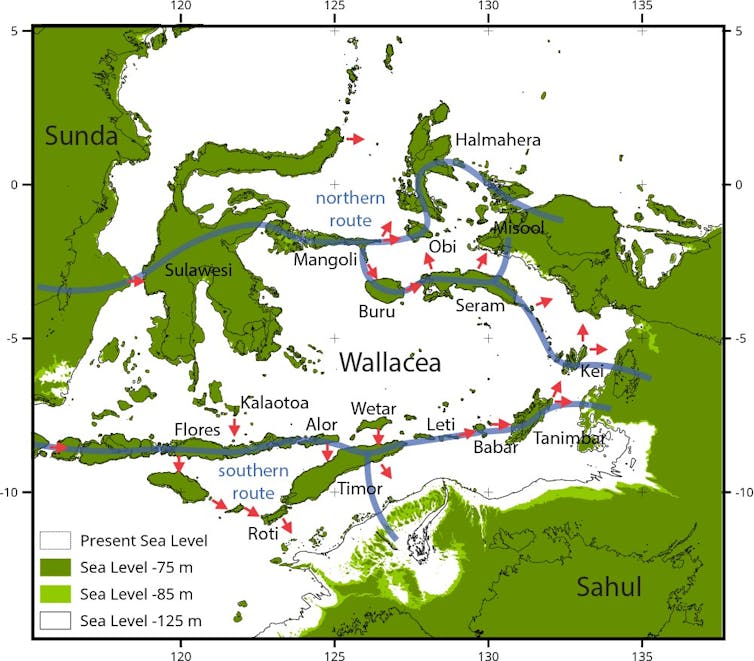
Modelled routes for making landfall in Sahul. Sea levels are shown at -75 m and -85 m. Potential northern and southern routes indicated by blue lines. Red arrows indicate the directions of modelled crossings. (Image credit: Michael Bird)
Next, we extended these demographic models to work out how many people would have had to arrive to survive in a new island continent, and to estimate the number of people the landscape could support.
We applied a unique combination of:
- fertility, longevity, and survival data from hunter-gatherer societies around the globe
- “hindcasts” of past climatic conditions from general circulation models (very much like what we use to forecast future climate changes)
- well-established principles of population ecology.
Our simulations indicate at least 1,300 people likely arrived in a single migration event to Sahul, regardless of the route taken. Any fewer than that, and they probably would not have survived – for the same reasons that it is unlikely that an endangered species can recover from only a few remaining individuals.
Alternatively, the probability of survival was also large if people arrived in smaller, successive waves, averaging at least 130 people every 70 or so years over the course of about 700 years.
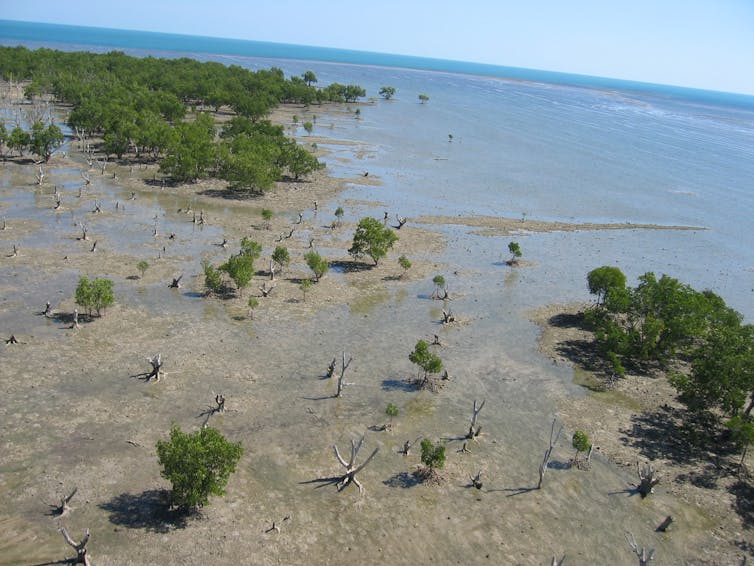
As sea levels rose, Australia was eventually cut off from New Guinea around 8,000 to 10,000 thousand years ago. (Image credit: Corey Bradshaw)
A planned arrival
Our data suggest that the peopling of Sahul could not have been an accident or random event. It was very much a planned and well-organised maritime migration.
Our results are similar to findings from several studies that also suggest this number of people is required to populate a new environment successfully, especially as people spread out of Africa and arrived in new regions around the world.
The overall implications of these results are fascinating. They verify that the first ancestors of Aboriginal, Torres Strait Islander, and Melanesian people to arrive in Sahul possessed sophisticated technological knowledge to build watercraft, and they were able to plan, navigate, and make complicated, open-ocean voyages to transport large numbers of people toward targeted destinations.
Our results also suggest that they did so by making many directed voyages, potentially over centuries, providing the beginnings of the complex, interconnected Indigenous societies that we see across the continent today.
Corey J. A. Bradshaw , Matthew Flinders Fellow in Global Ecology and Models Theme Leader for the ARC Centre of Excellence for Australian Biodiversity and Heritage, Flinders University ; Laura S. Weyrich , ARC Future Fellow, Metagenomic Cluster Lead at the Australian Centre for Ancient DNA, UoA Node Leader for the ARC Center of Excellence for Australian Biodiversity and Heritage, University of Adelaide ; Michael Bird , ARC Laureate Fellow, JCU Distinguished Professor, ARC Centre of Excellence for Australian Biodiversity and Heritage, James Cook University , and Sean Ulm , Deputy Director, ARC Centre of Excellence for Australian Biodiversity and Heritage, James Cook University
This article is republished from The Conversation under a Creative Commons license. Read the original article .

Why (most) Aussies love daylight saving
Daylight saving has 80 per cent support in Australia and a majority in every state.

Who invented the flat white?
Australia’s coffee culture – a source of great national pride – is usually associated with the wave of Greek and Italian migrants who settled in Melbourne and Sydney following the second world war. But it was very likely in regional Queensland that one of Australia’s favourite brews first took root.

Desert delight
The Great Victoria Desert, Australia’s largest, defies expectations. Visibly rich in biodiversity, it challenges preconceptions about how a desert should look.
Watch Latest Web Stories
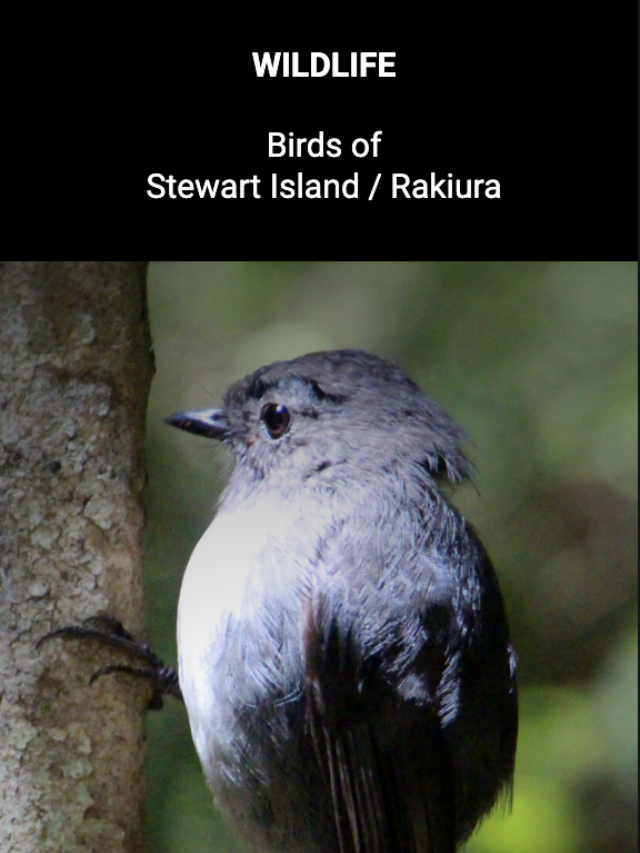
Birds of Stewart Island / Rakiura
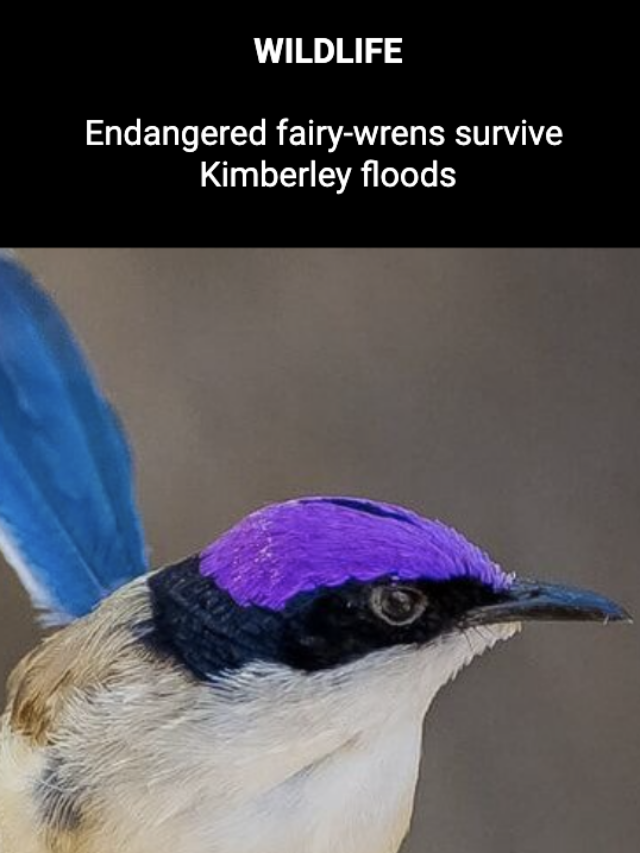
Endangered fairy-wrens survive Kimberley floods

Australia’s sleepiest species

2024 Calendars & Diaries - OUT NOW
Our much loved calendars and diaries are now available for 2024. Adorn your walls with beautiful artworks year round. Order today.

In stock now: Hansa Soft Toys and Puppets
From cuddly companions to realistic native Australian wildlife, the range also includes puppets that move and feel like real animals.
- Share full article
Advertisement
Supported by
Humans First Arrived in Australia 65,000 Years Ago, Study Suggests

By Nicholas St. Fleur
- July 19, 2017
The timing of the first arrival of humans in Australia has been studied and debated for decades. Now, researchers have found evidence that suggests the ancestors of Aboriginal Australians landed in the northern part of Australia at least 65,000 years ago.
The finding, which was published Wednesday in the journal Nature , pushes back the timing of when people first came to the continent by about 5,000 to 18,000 years. It also suggests that humans coexisted with colossal Australian animals like giant wombats and wallabies long before the megafauna went extinct.
“This is the earliest reliable date for human occupation in Australia,” Peter Hiscock , an archaeologist at the University of Sydney who was not involved in the study, said in an email. “This is indeed a marvelous step forward in our exploration of the human past in Australia.”
Previous archaeological digs and dating had suggested people migrated to Australia between 47,000 and 60,000 years ago. But a new excavation at an aboriginal rock shelter called Madjedbebe revealed human relics that dated back 65,000 years.
“We were gobsmacked by the richness of material that we were finding at the site: fireplaces intact, a ring of grind stones around it, and there were human burials in their graves,” said Chris Clarkson , an archaeologist from the University of Queensland in Australia and lead author of the study. “No one dreamed of a site so rich and so old in Australia.”
The Madjedbebe site had been studied in the 1970s. But during more recent visits in 2012 and 2015, Dr. Clarkson and his colleagues recovered more than 11,000 artifacts from the deepest layers of the excavation pit. In addition to uncovering leftovers of an ancient campfire and archaic mortars and pestles, they also found flaked stone tools and painting material. They also unearthed the earliest known examples of edge-ground axes, which are stone axes that would have had handles, which were 20,000 years older than those found anywhere else in the world.
Dr. Clarkson said that the finding provides further insight into the complex capabilities of ancient humans as well as the chronology of when they migrated from Africa and spread across the world.
He also added that the findings provide evidence against a prevailing theory that people rapidly drove Australia’s largest animals to extinction shortly after arriving on the continent.
“It puts to bed the whole idea that humans wiped them out,” said Dr. Clarkson. “We’re talking 20,000 to 25,000 years of coexistence.”
To determine the age of the artifacts, the team had to date the sediment layer where they were buried. They first performed radiocarbon dating on sediment starting at the surface until they got to layers that were about 37,000 years old. They then shifted to a technique called optically stimulated luminescence dating for the deepest layers, which was used to measure the last time the sand in the rock shelter was exposed to sunlight.
Think of a grain of sand as an empty battery that slowly collects charge once it’s buried. As long as it remains in the dark it will continue gaining energy over time. If researchers can recover the grain of sand, and keep it dark, they can then use a laser to release the ‘charge’ within it. By measuring the amount of energy the grain of sand releases, and comparing that with the amount of radiation that the sand was exposed to while it was buried, researchers can determine when it was last in sunlight.
When it was dark, Zenobia Jacobs , a geochronologist from the University of Wollongong, and her colleagues used long tubes to bore into the sand layers where they found artifacts and collected 56 samples. Back at the lab she painstakingly measured more than 28,500 individual grains of sand and used a laser to determine their ages. After getting her results, the team sent several samples to independent labs to double check its work. The results came back verified.
“It was a great relief, I can tell you that,” said Dr. Jacobs.
She also helped confirm that the sand had not been significantly disturbed for tens of thousands of years. That meant that it could provide an accurate assessment for the age of the artifacts.
Jean-Luc Schwenninger , head of the Luminescence Dating Laboratory at the University of Oxford who was not involved in the study, said in an email that the team’s use of luminescence dating techniques provides a convincing case that humans came to Australia 65,000 years ago.
“However, the results of this thorough study also seem to suggest that this might be a rather conservative age estimate,” said Dr. Schwenninger, “and I would not at all be surprised if this date was pushed back even further in the future.”
Like the Science Times page on Facebook. | Sign up for the Science Times newsletter.
Subscribe or renew today
Every print subscription comes with full digital access
Science News
Humans first settled in australia as early as 65,000 years ago.
Artifacts reveal a people skilled with stone tools, other crafts

HOME SWEET HOME Artifacts found at the ancient rock-shelter known as Madjedbebe (shown) in northern Australia provide new insights into the lives of the first Australians.
Dominic O'Brien/Gundjeihmi Aboriginal Corporation 2015
Share this:
By Maria Temming
July 19, 2017 at 1:00 pm
Tools, paints and other artifacts excavated from an ancient rock-shelter in northern Australia are giving new glimpses into early life Down Under. The first humans may have arrived on the continent 65,000 years ago — 5,000 years earlier than previously thought — and they were sophisticated craftspeople, researchers report July 19 in Nature .
Archaeologists unearthed three distinct layers of artifacts at Madjedbebe, Australia’s oldest known site of human habitation, during digs in 2012 and 2015. The oldest, deepest layer contained more than 10,000 relics of human handiwork. This cache included the world’s oldest polished ax heads, Australia’s oldest seed-grinding and pigment-processing tools, stone points that may have been spearheads, as well as hearths and other remnants of human activity.

“When people think about our ancient ancestors, they either tend to have a view that our ancestors must have been primitive, less culturally diverse, or they take the view that our ancestors were probably extraordinarily culturally impressive,” says Peter Hiscock, an archaeologist at the University of Sydney who was not involved in the study. “This indicates the latter view. The moment people get to Australia, they’re doing all this really smart stuff.” They were probably building fires to light nighttime activities, grinding seeds for food and using ochre paints to decorate cave walls or their own bodies, Hiscock says.
Previous estimates of the earliest human habitation of Australia — between 47,000 and 60,000 years ago — came from artifacts found at Madjedbebe in 1989. But archaeologists doubted those results because there were no detailed descriptions of the artifacts and it was unclear whether the artifacts were the same age as the surrounding sediment, says study coauthor Zenobia Jacobs, an archaeologist at the University of Wollongong in Australia.
Jacobs and colleagues estimated the ages of the newly uncovered artifacts by more precisely locating the artifacts underground and applying a method called optically stimulated luminescence dating, which reveals the last time a mineral grain was exposed to sunlight, to the sediment where the artifacts were found. Along with radiocarbon dating on charcoal remains from human-made fires, these analyses yielded a much more precise estimate for the age of sediments surrounding artifacts at various depths. The tests indicated that the deepest layer of artifacts — between about 2.15 and 2.6 meters below the surface — ranged in age from about 53,000 to 65,000 years.
Story continues after image

To say that humans first set foot in Australia exactly 65,000 years ago may be “a somewhat optimistic interpretation of the data,” Hiscock says. That’s because items buried in sand are liable to shift around a little. He suggests a more conservative estimate of human arrival between 55,000 and 60,000 years ago. Still, Hiscock says, that narrowed range is a major improvement over the wide, uncertain time span that archaeologists were working with before.
These new dates may provide insight into when humans migrated out of Africa ( SN: 12/24/16, p. 25 ). That in turn could help determine when humans interbred with archaic hominids on other continents — such as Neandertals in Europe and Denisovans in Asia — whose genes linger in the DNA of some modern people ( SN: 6/13/15, p. 11 ).
More Stories from Science News on Archaeology

Human brains found at archaeological sites are surprisingly well-preserved

These South American cave paintings reveal a surprisingly old tradition

This Stone Age wall may have led Eurasian reindeer to their doom

A four-holed piece of ivory provides a glimpse into ancient rope-making

Cold, dry snaps accompanied three plagues that struck the Roman Empire

An ancient, massive urban complex has been found in the Ecuadorian Amazon

How ancient herders rewrote northern Europeans’ genetic story

Here are some big-if-true scientific claims that made headlines in 2023
Subscribers, enter your e-mail address for full access to the Science News archives and digital editions.
Not a subscriber? Become one now .
The Great Human Migration
Why humans left their African homeland 80,000 years ago to colonize the world
Guy Gugliotta
/https://tf-cmsv2-smithsonianmag-media.s3.amazonaws.com/filer/migrations_jul08_631.jpg)
Seventy-seven thousand years ago, a craftsman sat in a cave in a limestone cliff overlooking the rocky coast of what is now the Indian Ocean. It was a beautiful spot, a workshop with a glorious natural picture window, cooled by a sea breeze in summer, warmed by a small fire in winter. The sandy cliff top above was covered with a white-flowering shrub that one distant day would be known as blombos and give this place the name Blombos Cave.
The man picked up a piece of reddish brown stone about three inches long that he—or she, no one knows—had polished. With a stone point, he etched a geometric design in the flat surface—simple crosshatchings framed by two parallel lines with a third line down the middle.
Today the stone offers no clue to its original purpose. It could have been a religious object, an ornament or just an ancient doodle. But to see it is to immediately recognize it as something only a person could have made. Carving the stone was a very human thing to do.
The scratchings on this piece of red ocher mudstone are the oldest known example of an intricate design made by a human being. The ability to create and communicate using such symbols, says Christopher Henshilwood, leader of the team that discovered the stone, is "an unambiguous marker" of modern humans, one of the characteristics that separate us from any other species, living or extinct.
Henshilwood, an archaeologist at Norway's University of Bergen and the University of the Witwatersrand, in South Africa, found the carving on land owned by his grandfather, near the southern tip of the African continent. Over the years, he had identified and excavated nine sites on the property, none more than 6,500 years old, and was not at first interested in this cliffside cave a few miles from the South African town of Still Bay. What he would find there, however, would change the way scientists think about the evolution of modern humans and the factors that triggered perhaps the most important event in human prehistory, when Homo sapiens left their African homeland to colonize the world.
This great migration brought our species to a position of world dominance that it has never relinquished and signaled the extinction of whatever competitors remained—Neanderthals in Europe and Asia, some scattered pockets of Homo erectus in the Far East and, if scholars ultimately decide they are in fact a separate species, some diminutive people from the Indonesian island of Flores (see "Were 'Hobbits' Human?"). When the migration was complete, Homo sapiens was the last—and only—man standing.
Even today researchers argue about what separates modern humans from other, extinct hominids. Generally speaking, moderns tend to be a slimmer, taller breed: "gracile," in scientific parlance, rather than "robust," like the heavy-boned Neanderthals, their contemporaries for perhaps 15,000 years in ice age Eurasia. The modern and Neanderthal brains were about the same size, but their skulls were shaped differently: the newcomers' skulls were flatter in back than the Neanderthals', and they had prominent jaws and a straight forehead without heavy brow ridges. Lighter bodies may have meant that modern humans needed less food, giving them a competitive advantage during hard times.
The moderns' behaviors were also different. Neanderthals made tools, but they worked with chunky flakes struck from large stones. Modern humans' stone tools and weapons usually featured elongated, standardized, finely crafted blades. Both species hunted and killed the same large mammals, including deer, horses, bison and wild cattle. But moderns' sophisticated weaponry, such as throwing spears with a variety of carefully wrought stone, bone and antler tips, made them more successful. And the tools may have kept them relatively safe; fossil evidence shows Neanderthals suffered grievous injuries, such as gorings and bone breaks, probably from hunting at close quarters with short, stone-tipped pikes and stabbing spears. Both species had rituals—Neanderthals buried their dead—and both made ornaments and jewelry. But the moderns produced their artifacts with a frequency and expertise that Neanderthals never matched. And Neanderthals, as far as we know, had nothing like the etching at Blombos Cave, let alone the bone carvings, ivory flutes and, ultimately, the mesmerizing cave paintings and rock art that modern humans left as snapshots of their world.
When the study of human origins intensified in the 20th century, two main theories emerged to explain the archaeological and fossil record: one, known as the multi-regional hypothesis, suggested that a species of human ancestor dispersed throughout the globe, and modern humans evolved from this predecessor in several different locations. The other, out-of-Africa theory, held that modern humans evolved in Africa for many thousands of years before they spread throughout the rest of the world.
In the 1980s, new tools completely changed the kinds of questions that scientists could answer about the past. By analyzing DNA in living human populations, geneticists could trace lineages backward in time. These analyses have provided key support for the out-of-Africa theory. Homo sapiens , this new evidence has repeatedly shown, evolved in Africa, probably around 200,000 years ago.
The first DNA studies of human evolution didn't use the DNA in a cell's nucleus—chromosomes inherited from both father and mother—but a shorter strand of DNA contained in the mitochondria, which are energy-producing structures inside most cells. Mitochondrial DNA is inherited only from the mother. Conveniently for scientists, mitochondrial DNA has a relatively high mutation rate, and mutations are carried along in subsequent generations. By comparing mutations in mitochondrial DNA among today's populations, and making assumptions about how frequently they occurred, scientists can walk the genetic code backward through generations, combining lineages in ever larger, earlier branches until they reach the evolutionary trunk.
At that point in human history, which scientists have calculated to be about 200,000 years ago, a woman existed whose mitochondrial DNA was the source of the mitochondrial DNA in every person alive today. That is, all of us are her descendants. Scientists call her "Eve." This is something of a misnomer, for Eve was neither the first modern human nor the only woman alive 200,000 years ago. But she did live at a time when the modern human population was small—about 10,000 people, according to one estimate. She is the only woman from that time to have an unbroken lineage of daughters, though she is neither our only ancestor nor our oldest ancestor. She is, instead, simply our "most recent common ancestor," at least when it comes to mitochondria. And Eve, mitochondrial DNA backtracking showed, lived in Africa.
Subsequent, more sophisticated analyses using DNA from the nucleus of cells have confirmed these findings, most recently in a study this year comparing nuclear DNA from 938 people from 51 parts of the world. This research, the most comprehensive to date, traced our common ancestor to Africa and clarified the ancestries of several populations in Europe and the Middle East.
While DNA studies have revolutionized the field of paleoanthropology, the story "is not as straightforward as people think," says University of Pennsylvania geneticist Sarah A. Tishkoff. If the rates of mutation, which are largely inferred, are not accurate, the migration timetable could be off by thousands of years.
To piece together humankind's great migration, scientists blend DNA analysis with archaeological and fossil evidence to try to create a coherent whole—no easy task. A disproportionate number of artifacts and fossils are from Europe—where researchers have been finding sites for well over 100 years—but there are huge gaps elsewhere. "Outside the Near East there is almost nothing from Asia, maybe ten dots you could put on a map," says Texas A&M University anthropologist Ted Goebel.
As the gaps are filled, the story is likely to change, but in broad outline, today's scientists believe that from their beginnings in Africa, the modern humans went first to Asia between 80,000 and 60,000 years ago. By 45,000 years ago, or possibly earlier, they had settled Indonesia, Papua New Guinea and Australia. The moderns entered Europe around 40,000 years ago, probably via two routes: from Turkey along the Danube corridor into eastern Europe, and along the Mediterranean coast. By 35,000 years ago, they were firmly established in most of the Old World. The Neanderthals, forced into mountain strongholds in Croatia, the Iberian Peninsula, the Crimea and elsewhere, would become extinct 25,000 years ago. Finally, around 15,000 years ago, humans crossed from Asia to North America and from there to South America.
Africa is relatively rich in the fossils of human ancestors who lived millions of years ago (see timeline, opposite). Lush, tropical lake country at the dawn of human evolution provided one congenial living habitat for such hominids as Australopithecus afarensis . Many such places are dry today, which makes for a congenial exploration habitat for paleontologists. Wind erosion exposes old bones that were covered in muck millions of years ago. Remains of early Homo sapiens , by contrast, are rare, not only in Africa, but also in Europe. One suspicion is that the early moderns on both continents did not—in contrast to Neanderthals—bury their dead, but either cremated them or left them to decompose in the open.
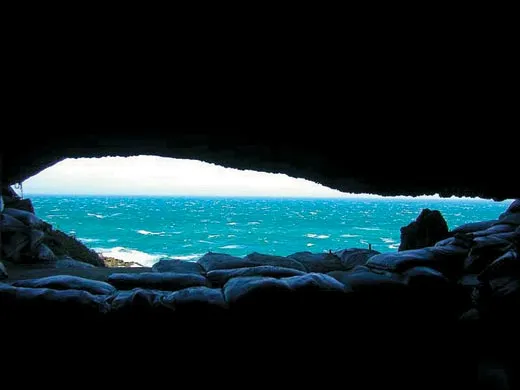
In 2003, a team of anthropologists reported the discovery of three unusual skulls—two adults and a child—at Herto, near the site of an ancient freshwater lake in northeast Ethiopia. The skulls were between 154,000 and 160,000 years old and had modern characteristics, but with some archaic features. "Even now I'm a little hesitant to call them anatomically modern," says team leader Tim White, from the University of California at Berkeley. "These are big, robust people, who haven't quite evolved into modern humans. Yet they are so close you wouldn't want to give them a different species name."
The Herto skulls fit with the DNA analysis suggesting that modern humans evolved some 200,000 years ago. But they also raised questions. There were no other skeletal remains at the site (although there was evidence of butchered hippopotamuses), and all three skulls, which were nearly complete except for jawbones, showed cut marks—signs of scraping with stone tools. It appeared that the skulls had been deliberately detached from their skeletons and defleshed. In fact, part of the child's skull was highly polished. "It is hard to argue that this is not some kind of mortuary ritual," White says.
Even more provocative were discoveries reported last year. In a cave at Pinnacle Point in South Africa, a team led by Arizona State University paleoanthropologist Curtis Marean found evidence that humans 164,000 years ago were eating shellfish, making complex tools and using red ocher pigment—all modern human behaviors. The shellfish remains—of mussels, periwinkles, barnacles and other mollusks—indicated that humans were exploiting the sea as a food source at least 40,000 years earlier than previously thought.
The first archaeological evidence of a human migration out of Africa was found in the caves of Qafzeh and Skhul, in present-day Israel. These sites, initially discovered in the 1930s, contained the remains of at least 11 modern humans. Most appeared to have been ritually buried. Artifacts at the site, however, were simple: hand axes and other Neanderthal-style tools.
At first, the skeletons were thought to be 50,000 years old—modern humans who had settled in the Levant on their way to Europe. But in 1989, new dating techniques showed them to be 90,000 to 100,000 years old, the oldest modern human remains ever found outside Africa. But this excursion appears to be a dead end: there is no evidence that these moderns survived for long, much less went on to colonize any other parts of the globe. They are therefore not considered to be a part of the migration that followed 10,000 or 20,000 years later.
Intriguingly, 70,000-year-old Neanderthal remains have been found in the same region. The moderns, it would appear, arrived first, only to move on, die off because of disease or natural catastrophe or—possibly—get wiped out. If they shared territory with Neanderthals, the more "robust" species may have outcompeted them here. "You may be anatomically modern and display modern behaviors," says paleoanthropologist Nicholas J. Conard of Germany's University of Tübingen, "but apparently it wasn't enough. At that point the two species are on pretty equal footing." It was also at this point in history, scientists concluded, that the Africans ceded Asia to the Neanderthals.
Then, about 80,000 years ago, says Blombos archaeologist Henshilwood, modern humans entered a "dynamic period" of innovation. The evidence comes from such South African cave sites as Blombos, Klasies River, Diepkloof and Sibudu. In addition to the ocher carving, the Blombos Cave yielded perforated ornamental shell beads—among the world's first known jewelry. Pieces of inscribed ostrich eggshell turned up at Diepkloof. Hafted points at Sibudu and elsewhere hint that the moderns of southern Africa used throwing spears and arrows. Fine-grained stone needed for careful workmanship had been transported from up to 18 miles away, which suggests they had some sort of trade. Bones at several South African sites showed that humans were killing eland, springbok and even seals. At Klasies River, traces of burned vegetation suggest that the ancient hunter-gatherers may have figured out that by clearing land, they could encourage quicker growth of edible roots and tubers. The sophisticated bone tool and stoneworking technologies at these sites were all from roughly the same time period—between 75,000 and 55,000 years ago.
Virtually all of these sites had piles of seashells. Together with the much older evidence from the cave at Pinnacle Point, the shells suggest that seafood may have served as a nutritional trigger at a crucial point in human history, providing the fatty acids that modern humans needed to fuel their outsize brains: "This is the evolutionary driving force," says University of Cape Town archaeologist John Parkington. "It is sucking people into being more cognitively aware, faster-wired, faster-brained, smarter." Stanford University paleoanthropologist Richard Klein has long argued that a genetic mutation at roughly this point in human history provoked a sudden increase in brainpower, perhaps linked to the onset of speech.
Did new technology, improved nutrition or some genetic mutation allow modern humans to explore the world? Possibly, but other scholars point to more mundane factors that may have contributed to the exodus from Africa. A recent DNA study suggests that massive droughts before the great migration split Africa's modern human population into small, isolated groups and may have even threatened their extinction. Only after the weather improved were the survivors able to reunite, multiply and, in the end, emigrate. Improvements in technology may have helped some of them set out for new territory. Or cold snaps may have lowered sea level and opened new land bridges.
Whatever the reason, the ancient Africans reached a watershed. They were ready to leave, and they did.
DNA evidence suggests the original exodus involved anywhere from 1,000 to 50,000 people. Scientists do not agree on the time of the departure—sometime more recently than 80,000 years ago—or the departure point, but most now appear to be leaning away from the Sinai, once the favored location, and toward a land bridge crossing what today is the Bab el Mandeb Strait separating Djibouti from the Arabian Peninsula at the southern end of the Red Sea. From there, the thinking goes, migrants could have followed a southern route eastward along the coast of the Indian Ocean. "It could have been almost accidental," Henshilwood says, a path of least resistance that did not require adaptations to different climates, topographies or diet. The migrants' path never veered far from the sea, departed from warm weather or failed to provide familiar food, such as shellfish and tropical fruit.
Tools found at Jwalapuram, a 74,000-year-old site in southern India, match those used in Africa from the same period. Anthropologist Michael Petraglia of the University of Cambridge, who led the dig, says that although no human fossils have been found to confirm the presence of modern humans at Jwalapuram, the tools suggest it is the earliest known settlement of modern humans outside of Africa except for the dead enders at Israel's Qafzeh and Skhul sites.
And that's about all the physical evidence there is for tracking the migrants' early progress across Asia. To the south, the fossil and archaeological record is clearer and shows that modern humans reached Australia and Papua New Guinea—then part of the same landmass—at least 45,000 years ago, and maybe much earlier.
But curiously, the early down under colonists apparently did not make sophisticated tools, relying instead on simple Neanderthal-style flaked stones and scrapers. They had few ornaments and little long-distance trade, and left scant evidence that they hunted large marsupial mammals in their new homeland. Of course, they may have used sophisticated wood or bamboo tools that have decayed. But University of Utah anthropologist James F. O'Connell offers another explanation: the early settlers did not bother with sophisticated technologies because they did not need them. That these people were "modern" and innovative is clear: getting to New Guinea-Australia from the mainland required at least one sea voyage of more than 45 miles, an astounding achievement. But once in place, the colonists faced few pressures to innovate or adapt new technologies. In particular, O'Connell notes, there were few people, no shortage of food and no need to compete with an indigenous population like Europe's Neanderthals.
Modern humans eventually made their first forays into Europe only about 40,000 years ago, presumably delayed by relatively cold and inhospitable weather and a less than welcoming Neanderthal population. The conquest of the continent—if that is what it was—is thought to have lasted about 15,000 years, as the last pockets of Neanderthals dwindled to extinction. The European penetration is widely regarded as the decisive event of the great migration, eliminating as it did our last rivals and enabling the moderns to survive there uncontested.
Did modern humans wipe out the competition, absorb them through interbreeding, outthink them or simply stand by while climate, dwindling resources, an epidemic or some other natural phenomenon did the job? Perhaps all of the above. Archaeologists have found little direct evidence of confrontation between the two peoples. Skeletal evidence of possible interbreeding is sparse, contentious and inconclusive. And while interbreeding may well have taken place, recent DNA studies have failed to show any consistent genetic relationship between modern humans and Neanderthals.
"You are always looking for a neat answer, but my feeling is that you should use your imagination," says Harvard University archaeologist Ofer Bar-Yosef. "There may have been positive interaction with the diffusion of technology from one group to the other. Or the modern humans could have killed off the Neanderthals. Or the Neanderthals could have just died out. Instead of subscribing to one hypothesis or two, I see a composite."
Modern humans' next conquest was the New World, which they reached by the Bering Land Bridge—or possibly by boat—at least 15,000 years ago. Some of the oldest unambiguous evidence of humans in the New World is human DNA extracted from coprolites—fossilized feces—found in Oregon and recently carbon dated to 14,300 years ago.
For many years paleontologists still had one gap in their story of how humans conquered the world. They had no human fossils from sub-Saharan Africa from between 15,000 and 70,000 years ago. Because the epoch of the great migration was a blank slate, they could not say for sure that the modern humans who invaded Europe were functionally identical to those who stayed behind in Africa. But one day in 1999, anthropologist Alan Morris of South Africa's University of Cape Town showed Frederick Grine, a visiting colleague from Stony Brook University, an unusual-looking skull on his bookcase. Morris told Grine that the skull had been discovered in the 1950s at Hofmeyr, in South Africa. No other bones had been found near it, and its original resting place had been befouled by river sediment. Any archaeological evidence from the site had been destroyed—the skull was a seemingly useless artifact.
But Grine noticed that the braincase was filled with a carbonate sand matrix. Using a technique unavailable in the 1950s, Grine, Morris and an Oxford University-led team of analysts measured radioactive particles in the matrix. The skull, they learned, was 36,000 years old. Comparing it with skulls from Neanderthals, early modern Europeans and contemporary humans, they discovered it had nothing in common with Neanderthal skulls and only peripheral similarities with any of today's populations. But it matched the early Europeans elegantly. The evidence was clear. Thirty-six thousand years ago, says Morris, before the world's human population differentiated into the mishmash of races and ethnicities that exist today, "We were all Africans."
Get the latest History stories in your inbox?
Click to visit our Privacy Statement .
Aboriginal and Torres Strait Islander people should be aware this website contains images, voices and names of people who have died.
Learning module:
Deep time history of australia.
Investigation 2: Two big ideas in deep time history in Australia

2.1 Introduction

2.2 Big Idea 1: Scientists believe that the first Australians came from somewhere else
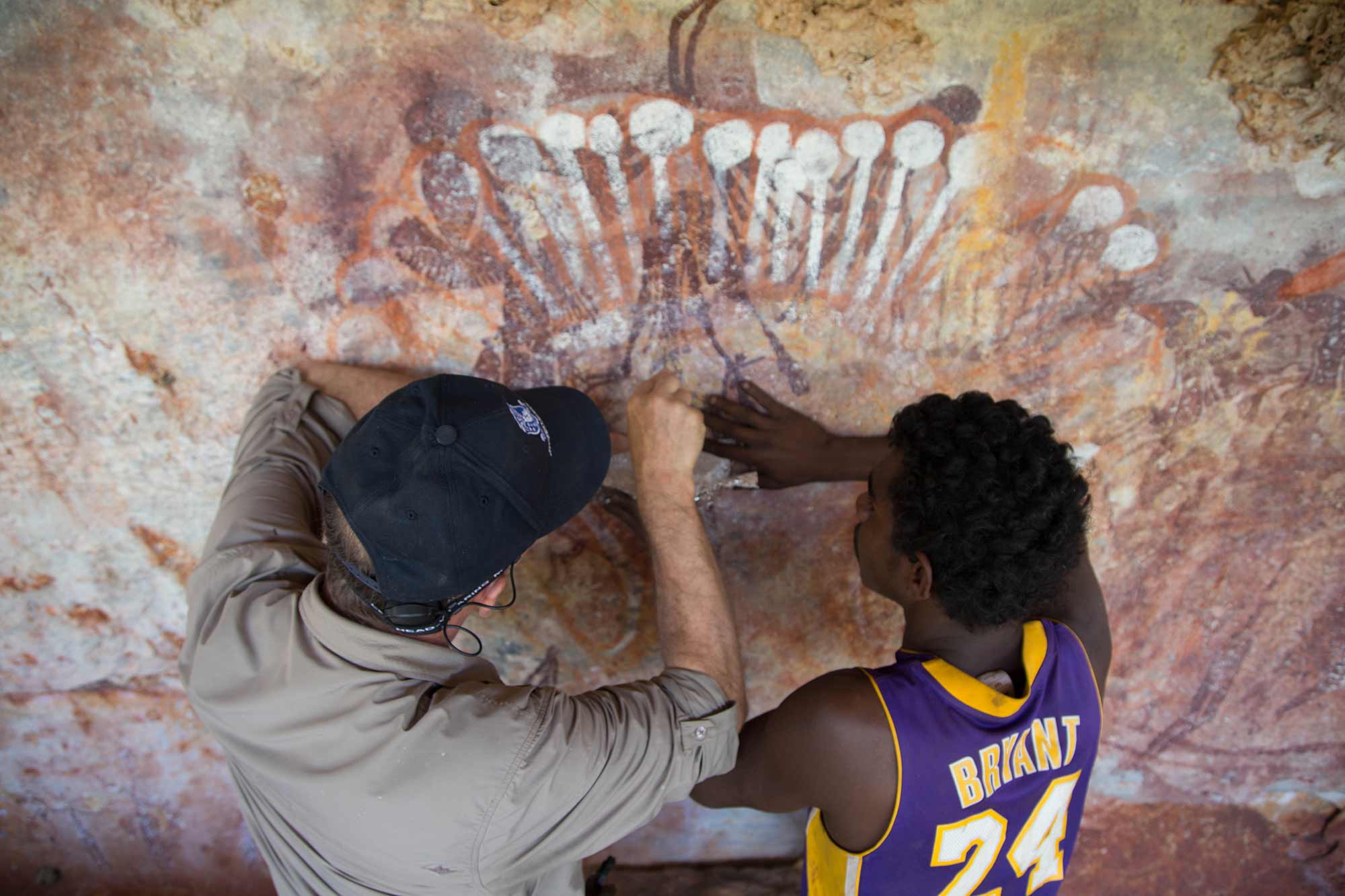
2.3 Big Idea 2: We can learn about Aboriginal culture in ancient Australia from archaeology
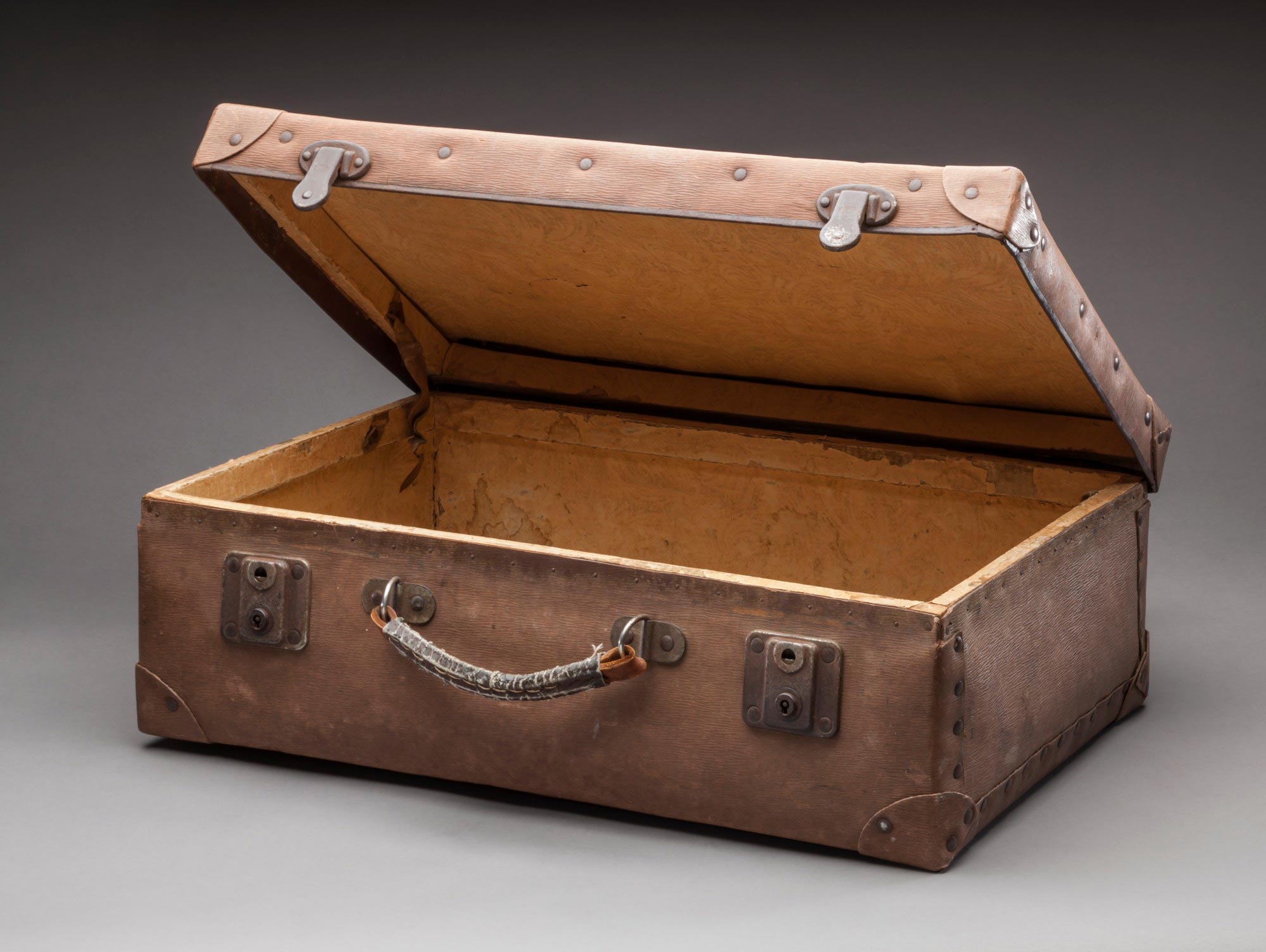
2.4 What have we learned about ancient or deep time Australia?
The arrival of the first australians.

National Museum of Australia
Islands in the Torres Strait
Where did the first Australians come from?
The Australian people arrive in Australia.
How did people know there was land?
Using DNA and archaeological evidence.
Aboriginal and Torres Strait Islander people believe that people have always been in Australia. They are part of the Dreaming, the time of creation of all the world.
Scientists and archaeologists believe that the first people arrived in Australia from somewhere else, between 50,000 years ago and 65,000 years ago. Estimates of when people first arrived in Australia is constantly changing as new evidence is discovered and as scientific techniques of measuring the past are improved.
Scientists do not know how or where modern humans developed, but there are currently two main scientific ideas that are under investigation.
The first scientific idea is that modern humans or homo sapiens developed quite suddenly in Africa and then spread, eventually displacing all earlier types of homo erectus (pre-modern humans) such as Neanderthals, which had been around for about 2 million years.
This might have looked a little like this:
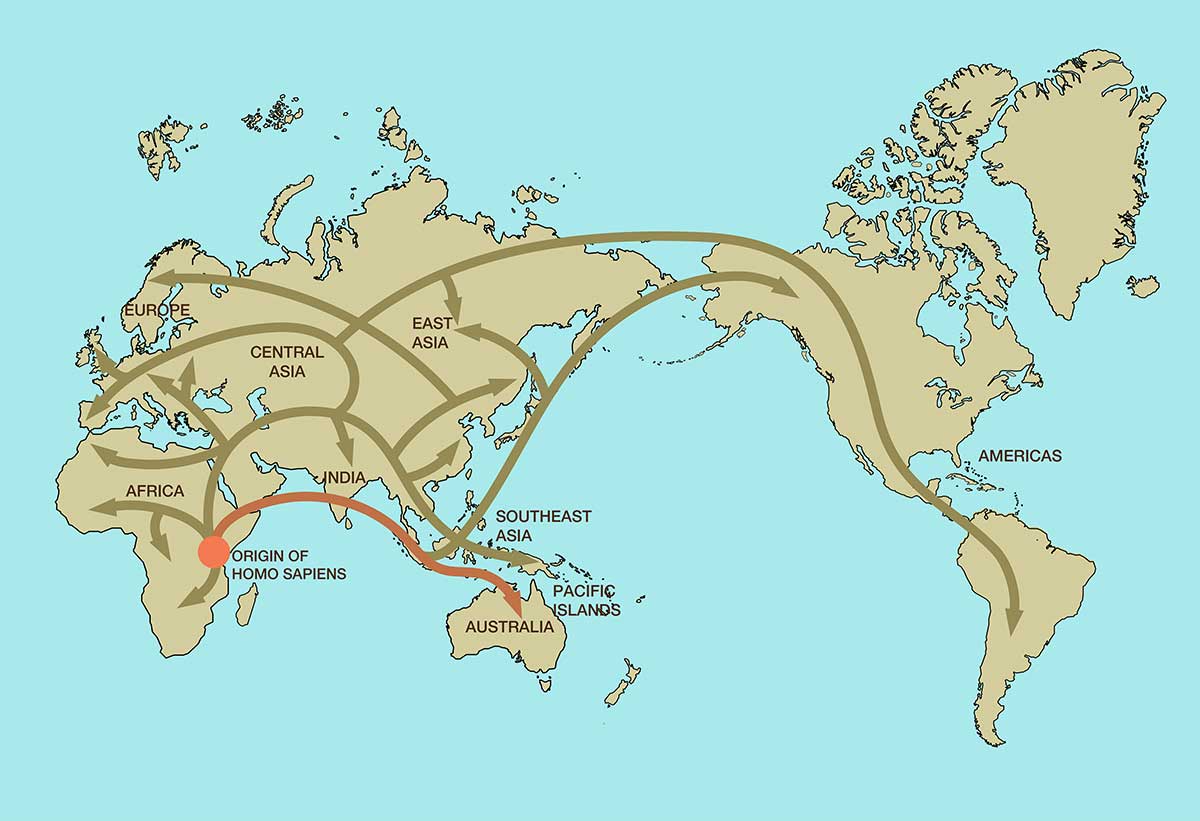
Eliane Touma
Map showing possible routes taken by homo sapiens out of Africa
The second scientific idea is that modern humans appeared in many parts of the world at about the same time , mixing with earlier types of homo erectus .
Whichever way this happened, according to science, the earliest humans made their way through Asia and eventually moved southwards towards the Australian continent.
The first people arrive in Australia
Australia looked very different 65,000 years ago. The continent was larger than it is today. Some land that existed in ancient times is now under the sea. Australia was also joined to other land masses that are now separate islands.
Map A: Australia and South East Asia today
Map B: Land in Australia and South East Asia today and 65,000 years ago
Map C: Most likely ancient migration routes to Australia

Adapted from Stuart Hawkins et al., ‘Oldest human occupation of Wallacea at Laili Cave, Timor-Leste, shows broad-spectrum foraging responses to late Pleistocene environments’, Quaternary Science Reviews, vol. 171, 2017, p. 59
1. Map A shows what Australia looks like now. Map B shows what it looked like about 65,000 years ago. There was much more land as the sea was much lower than it is today. Which two large islands, one in the north and one in the south, were joined to Australia then?
2. Map C shows how people might have migrated to Australia at this time. This map shows some different possible landing points. Why do you think scientists are not sure which landing points Aboriginal people used? [Hint: think about the evidence that would be needed to confirm this and the difficulty of finding this evidence many thousands of years later.]
The first people probably came to Australia from around the area that is now Timor. To get to Australia, they must have made a canoe voyage of about 90 to 150 kilometres of open water, which would have been a remarkable maritime achievement. But how did they know that Australia was there?
Imagine that you are about to go on a trip to another place. You cannot see the land — but you know it exists. How might you know that land exists?
3. Write down how each of the hints below might have told people that there was land even though they could not see it. If you need more help, hover over the relevant clue at the bottom.
a) Birds would help you know that there was land because…
b) Clouds would help you know that there was land because…
c) Smoke would help you know that there was land because…
d) Floating vegetation would help you know that there was land because…
Where are birds’ nests found?
Where do clouds form?
What might cause smoke?
Where might the vegetation have come from?
Another possibility is that people could see the land, and that was how they knew it was there. Then perhaps they could ‘island hop’ towards Australia.
A recent scientific study might explain what happened. We know that there is ancient land that is now under water off the Australian coast. These would have only been partly under water when people first came to Australia. They would have been islands then. Scientists have worked out how far away each of these hundreds of islands would have been from each other, and whether a person standing on the highest point of each island could have seen another island in the distance. If they could see another island, they could travel there and see the next island. In this way they could in theory have ‘island-hopped’ from Asia to Australia, paddling or sailing canoes from Timor to Australia, perhaps using the summer north-west winds that blow strongly from Timor towards Australia.
4. We will never find any physical evidence (such as spears, clubs, paintings or bones) from the first people who arrived on the Australian landmass. Why not?
Using DNA and archaeological evidence
Another theory is based on a study of the DNA of Aboriginal and Torres Strait Islander people in Australia.
DNA is deoxyribonucleic acid. It is the hereditary material in humans and other life forms. It makes us what we are. We inherit it from our parents. People of different regions have some differences in their DNA, so analysing a person’s DNA can help you trace back their family history over many thousands of years.
Modern DNA studies suggest that Australian Aboriginal people, Papua New Guinean highlanders and the Mamanawa people of the Philippines were all descended from the same group who left Africa, and settled in different places after a journey of several thousand years.
People who have the same ancestors have very similar DNA. By studying DNA samples taken from Aboriginal people living in Australia today, scientists have been able to see when and where people settled across ancient Australia.
Look at this map. The dots show different archaeological sites around Australia and the age of what was found there. The archaeological and DNA evidence show similar timeframes for the movement of people across ancient Australia.
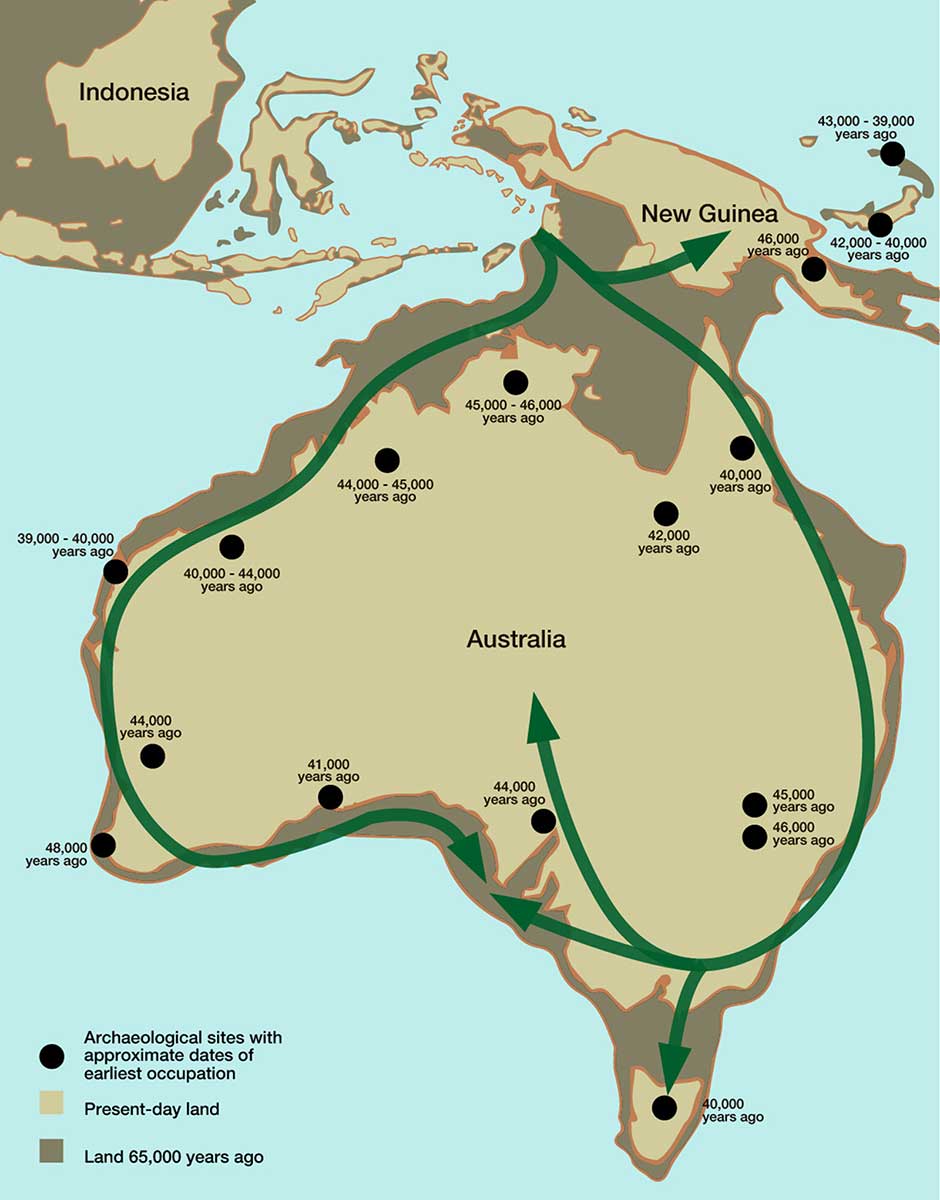
Adapted from Ray Tobler et al., ‘Aboriginal mitogenomes reveal 50,000 years of regionalism in Australia’, Nature, vol. 544, no. 7649, 2017, p. 183
Map showing archaeological data and the likely migration routes of people around Australia
Use the map to answer these questions.
5. It is likely that people came to Australia from one of the landmasses to the west. Which modern country does the map suggest that was?
6. According to this evidence, people probably came down which side of Australia? How does the evidence show this?
7. When had people moved to all parts of Australia and Tasmania? (Hint: what is the most recent date you can find on the map?)
Why did people come to Australia? Was it an accidental voyage, such as a group of people out fishing being caught in a storm and washed off course? Or was it deliberate, a group of people setting off to settle in the new place — perhaps to escape conflict, or population pressures, or just out of a spirit of adventure?
We can probably never know. But whether it was accidental or deliberate, one voyage or many, imagine what the people would have felt as they waded ashore onto this new land.
8. List some emotions that you think they might have felt.
A term referring to the distant past.
In your report make sure you explain:
- where Australians came from
- how they knew that there was land to go to
- where they landed first
- when this movement happened
- what the evidence is that tells us this, and what evidence is not available
- what this can tell us about ancient or Deep Time Australia.
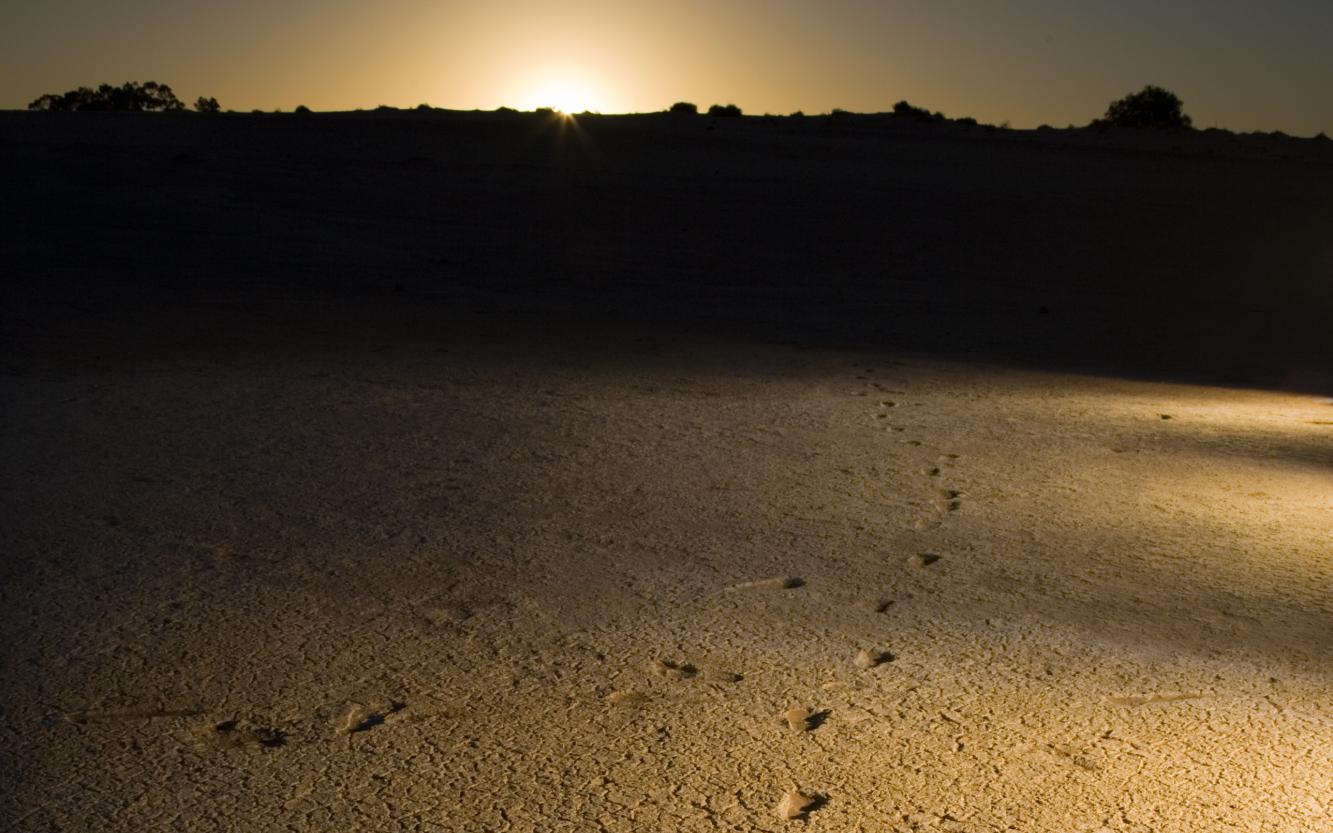
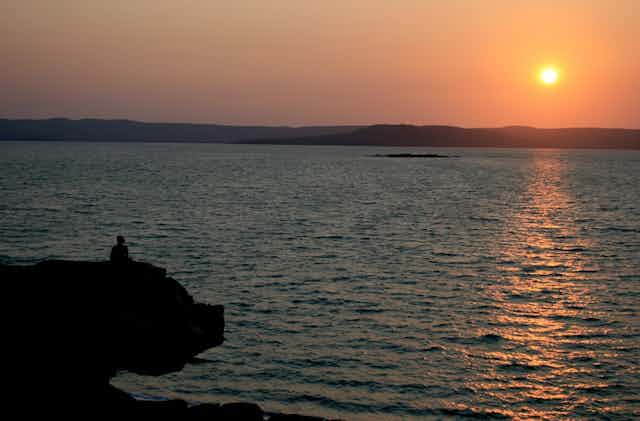
How to get to Australia … more than 50,000 years ago
Deputy Director, ARC Centre of Excellence for Australian Biodiversity and Heritage, James Cook University
Director, Australian Centre for Ancient DNA, University of Adelaide
ARC Laureate Fellow, JCU Distinguished Professor and Landscapes Theme Leader for the ARC Centre of Excellence for Australian Biodiversity and Heritage, James Cook University
Kimberley Foundation Ian Potter Chair in Rock Art and Professor of Australian Archaeology, Centre for Rock Art Research and Management, The University of Western Australia
Research Fellow, College of Science and Engineering, James Cook University
Senior Principal Research Scientist, CSIRO
Disclosure statement
Sean Ulm receives funding from the Australian Research Council.
Alan Cooper receives funding from the Australian Research Council
Michael Bird receives funding from the Australian Research Council.
Peter Veth receives funding from the Australian Research Council and the Kimberley Foundation Australia.
Robin Beaman receives funding from Geoscience Australia and the Qld Dept of Environment and Science.
Scott Condie receives funding from a wide range of government organisations, foundations and industry.
University of Western Australia and CSIRO provide funding as founding partners of The Conversation AU.
James Cook University and University of Adelaide provide funding as members of The Conversation AU.
View all partners
- Bahasa Indonesia
Over just the past few years, new archaeological findings have revealed the lives of early Aboriginal Australians in the Northern Territory’s Kakadu potentially as early as 65,000 years ago , from the Kimberley and Pilbara regions of Western Australia by about 50,000 years ago , and the Flinders Ranges of South Australia by around 49,000 years ago .
But how was it even possible for people to get to Australia in the first place? And how many people must have made it to Australia to explain the diversity of Aboriginal people today?
In a study published in Quaternary Science Reviews this week, we use new environmental reconstructions, voyage simulations, and genetic population estimates to show for the first time that colonisation of Australia by 50,000 years ago was achieved by a globally significant phase of purposeful and coordinated marine voyaging.
Past environments
Australia has never been connected by dry land to Southeast Asia. But at the time that people first arrived in Australia, sea levels were much lower , joining the Australian mainland to both Tasmania and New Guinea.
Read more: Australia's coastal living is at risk from sea level rise, but it's happened before
Our analysis using new high-resolution mapping of the seafloor shows that when sea levels were 75m or lower than present, a string of more than 100 habitable, resource-rich islands were present off the coast of northwest Australia.
These islands were directly visible from high points on the islands of Timor and Roti and as close as 87km.
This chain of now mostly submerged islands - the Sahul Banks - was almost 700km long. They represented a very large target for either accidental or purposeful arrival.
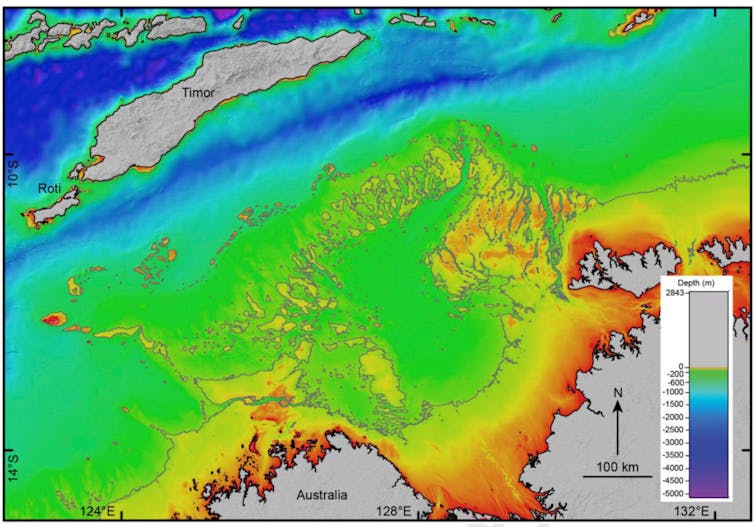
How difficult was it to get to Australia?
Combining modelled winds and ocean currents with particle trajectory modelling, we simulated voyages from three sites on the islands of Timor and Roti. This is similar to the approach used to model the movements of wreckage from the missing Malaysia Airlines flight MH370 .
In our model, we simulated the “launch” of 100 vessels from each site on February 1 each year for 15 years. The date was chosen to correspond to the main summer monsoon period when winds are generally blowing to the east-southeast, thereby maximising the chance of successful crossings.

The results clearly indicate that accidental arrival by drifting alone is very unlikely at any time. But the addition of even modest paddling towards the Sahul Banks islands results in a high proportion of successful arrivals over four to seven days. The highest probability of a successful landfall is associated with launching points on western Timor and Roti.

How many people did it take to colonise Australia?
Researchers have long speculated about how many people originally colonised Australia. Some have argued that Australia must have been colonised by accident, perhaps by just a few people.
Others have suggested a steady trickle of colonists. Estimates of the founding population have ranged from 1,000 to 3,000 .
The genetic evidence shows that Australia was colonised in a single phase, perhaps at multiple locations, but with very limited gene flow after initial colonisation.
Read more: DNA reveals Aboriginal people had a long and settled connection to country
The diversity of mitochondrial DNA lineages found in Aboriginal populations allows us to estimate the minimum size of the original colonising population. Mitochondrial DNA is only inherited from mothers.
Aboriginal mitochondrial DNA diversity alone represents at least nine to ten separate lineages.
Assuming that every mitochondrial lineage was represented in the founding population by four to five females (such as a family group containing a mother and her sister, and two daughters) the currently known nine to ten lineages would equate to around 36-50 females.
This is a conservative estimate, as founding populations of fewer than ten females per lineage have a low chance of long-term survival due to variations in reproductive success.
If an overall, again conservative, female to male ratio of 1:1 is assumed for the colonising party, the inferred founding population would be around 72-100 people. It was likely much larger (perhaps 200-300) because of the strong potential for related family groups to share similar mitochondrial lineages, which would be underestimated as a single founding lineage.
Clearly, a population of even the minimum estimated size is unlikely to have arrived accidentally on Sahul.
What does it all mean?
A lot of earlier thinking about how people arrived in Australia was based on the assumption that the first modern humans to sweep out of Africa and colonise the distant lands of Australia and New Guinea were somehow more limited in their cognitive and technological capacities than later humans (that is, all of “us”).
Therefore, models routinely assumed that people island-hopped short distances rather than making long journeys, probably ending up in Australia by accident.
Our results show that colonisation of Australia and New Guinea was no accident. Colonisation of Australia was more likely achieved by purposeful and coordinated marine voyaging, undertaken in the knowledge that land existed to the south of Timor/Roti.
The crossing to Australia was two to three times longer than the multiple previous shorter crossings required to reach the islands of Timor and Roti. This last voyage to reach Australia would have required watercraft construction, sailing and navigation technology, planning ability, information sharing and provisions to sustain an open ocean voyage over four to seven days.
Read more: Island-hopping study shows the most likely route the first people took to Australia
Purposeful voyaging on this scale clearly required advanced cognitive, linguistic, symbolic and technological capabilities. Critically, this finding places a unique global time-stamp on the cognitive abilities of our ancestors .
In the same way that we have underestimated the abilities of our human ancestors , we have underestimated the ability of early modern humans to plan, coordinate and undertake large-scale coordinated maritime voyaging across open water to reach Australia. The settling of Australia represents the earliest known maritime diaspora in the world.
This emerging picture of modern humans with advanced maritime capabilities deliberately settling the driest continent on the planet reminds us we still have much to learn about the complexity and adaptability of the First Australians.
- Aboriginal life
- Aboriginal history
- First Australians
- Aboriginal migration
- Global perspectives

Project Officer, Student Volunteer Program

Audience Development Coordinator (fixed-term maternity cover)

Lecturer (Hindi-Urdu)

Director, Defence and Security

Opportunities with the new CIEHF

How did the first humans reach Australia?
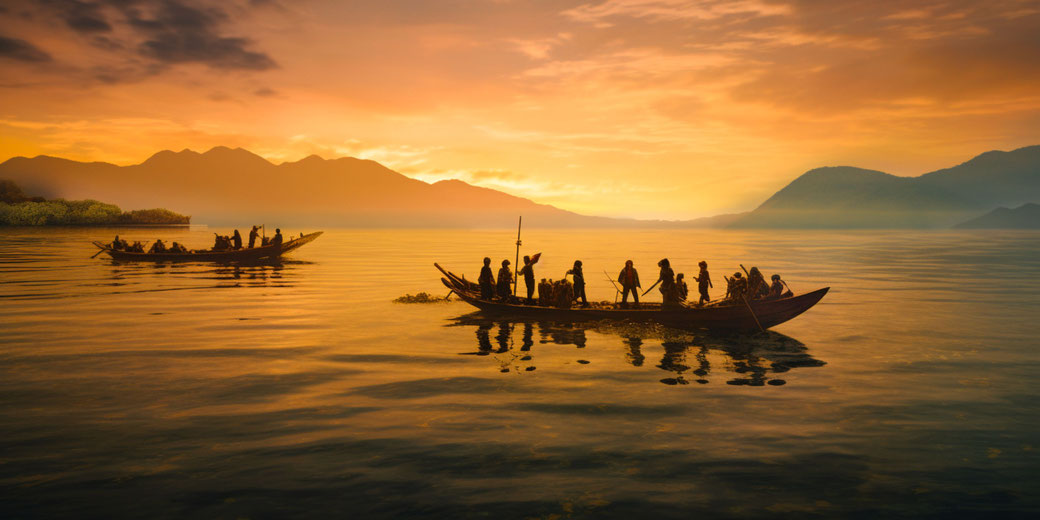
Long before the skyscrapers of Sydney or the bustling streets of Melbourne, Australia was home to its First Nations people.
These are the indigenous communities that have lived on the continent for tens of thousands of years.
But how did they get there, and how did they spread across such a vast land?
The first steps on Australian soil
The first humans reached Australia around 65,000 years ago , having embarked on a remarkable journey that took them from their origins in Africa to the shores of a distant and unexplored continent.
They had traveled through Asia, navigating challenging terrains and adapting to new environments as the world's climate changed over thousands of years.
The final leg of their journey involved crossing the sea, which they likely accomplished using primitive boats or rafts , by navigating through islands and relying on their knowledge of the stars and currents.
Once they landed on the northern coasts, they became the first humans to set foot on the Australian continent.
However, the landscape they encountered was very different to modern Australia and was called Sahul.
What was ancient Australia like?
Sahul is the name given to the combined landmass that, during periods of lower sea levels, connected what are now Australia, New Guinea, and Tasmania.
This vast continent existed during the Pleistocene epoch, when ice ages caused significant amounts of water to be locked up in glaciers and polar ice caps.
As a result, sea levels dropped, revealing land bridges and allowing for the movement of plants, animals, and eventually humans.
As sea levels were lower, early humans could move more easily between regions that are now separated by water.
The diverse landscapes of Sahul, ranging from tropical rainforests to vast deserts, provided a variety of habitats for its inhabitants.
The flora and fauna of Sahul were also unique, with many species, such as the kangaroo and the Tasmanian devil, evolving in isolation from the rest of the world.
However, as the ice ages ended and the global climate warmed, the glaciers and ice caps melted, causing sea levels to rise.
This led to the flooding of the land bridges and the separation of Australia, New Guinea, and Tasmania into distinct landmasses.

How humans spread across the land
After their arrival, these early Australians began to explore and settle in different parts of the continent.
They moved along the rivers and coastlines, and slowly ventured into the heart of the land.
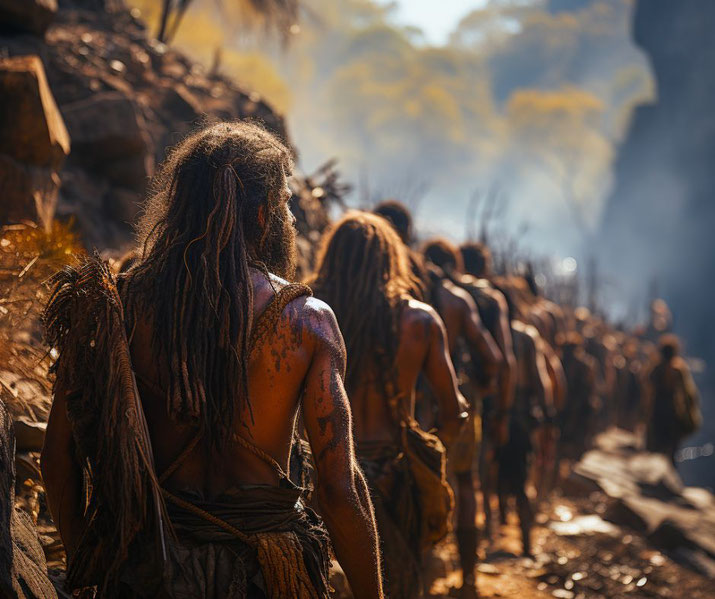
As they moved, they adapted to each new environment . In the coastal areas, they became skilled fishermen, using nets and spears to catch fish.
In the forests, they hunted kangaroos and other animals, and gathered fruits and nuts. In the arid deserts, they found ways to find water and food in such a challenging environment.
Cultural connections and stories
As these early Australians settled in different regions, they developed unique cultures, languages, and traditions .
They shared stories about the land, the animals, and the stars, which helped them understand their world and their place in it.
These stories, known as Dreamtime stories, explained how the world was created and how people should live in harmony with nature.
One famous Dreamtime story is about the Rainbow Serpent, a powerful creature that shaped the mountains, rivers, and lakes.
Another tells of Tiddalik the frog, who drank all the water in the world and caused a drought, until he was made to laugh and release the water.
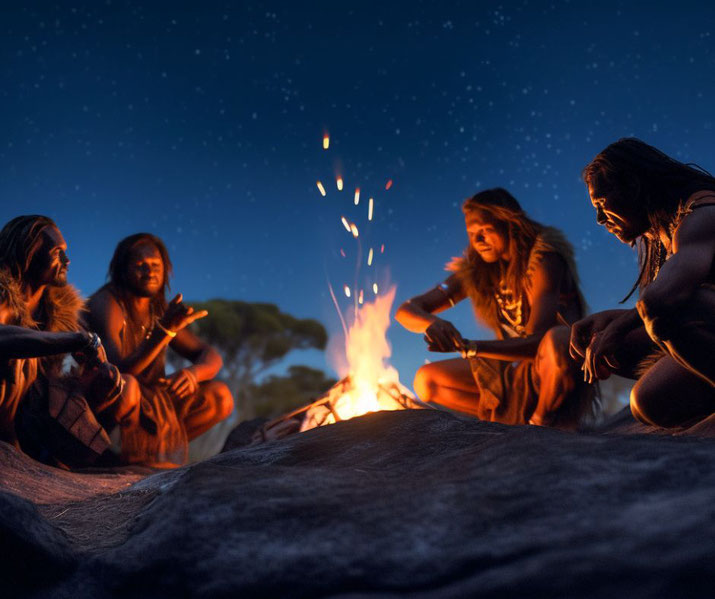
The journey and settlement of the First Nations Australians is a remarkable story of exploration, adaptation, and survival.
Over thousands of years, they have shaped the culture and history of Australia, leaving behind art, stories, and traditions that continue to be celebrated today.
What do you need help with?
Download ready-to-use digital learning resources.

Copyright © History Skills 2014-2024.
Contact via email

This website has been archived and is no longer updated.
Nsw migration heritage centre, documenting australia's migration history.

Australia 50000 Years Ago
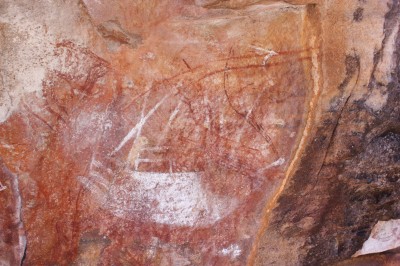
Homo sapiens or humans evolved in Africa about 200,000 years ago, reaching modernity about 50,000 years ago. Prior to the arrival of humans in Europe, the Middle East and Asia, these places were inhabited by another species of hominoid, Homo heidelbergensis or Neanderthals . Neanderthals begin to show on the archaeological record at around 400,000 years ago and became extinct at about 35,000 years ago with the arrival of humans. Humans are so adaptable we have migrated to almost every part of the world and in the process forced the extinction of all other species of hominoids. We are the only species of hominoid left.
About 180,000 years ago humans successfully migrated out of Africa. By about 50,000 years ago we were already beginning to diverge into distinct populations.
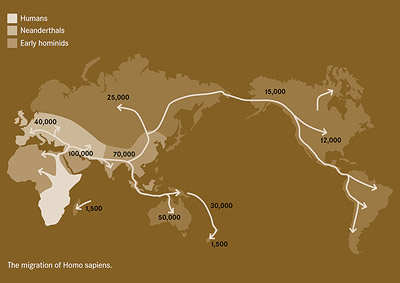
Our species evolved in Africa 200,000 years ago. The Genographic Project has found that people spread out of Africa in at least two migratory waves. The first wave travelled from eastern Africa into the area of the east coast of the Mediterranean known as the Levant about 80,000 years ago.
The later second wave moved from Africa into the Arabian Peninsula and continued eastward following the coast of South Asia about 50,000 years ago. This southern wave kept rolling along reaching Southeast Asia, where one branch of people migrated to Australia and New Guinea, while other branches moved along the coast of east Asia. A branch of this second wave migration moved north, into the central Asia and spread west into Europe and east into Siberia about 40,000 years ago. Eventually humans made their way to the American continent about 20,000 years ago.
The actual timing of the southern wave of humans is hard to ascertain because it appears to have moved along the coast, where after the end of the last Ice Age 12,000 years ago the melting glaciers drowned large stretches of coastline so the evidence is now under the ocean. The fossils we have of these migrants offer few clues as to what sparked their spread.
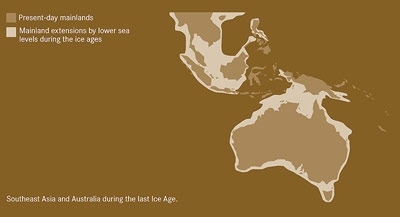
Migration to the Australian continent for these travellers was a difficult task. Australia is separated from Southeast Asia by a great expanse of water. During the last Ice Age, the distance was smaller because so much water was frozen in glaciers. But before 50,000 years ago humans would still have faced a voyage across fifty miles of open sea to get to Australia. They must have built sea craft strong enough to survive the voyage, a technological feat that went beyond making spears or lighting fires.
The first Aboriginal people arrived on the north west coast of Australia between 65,000 and 40,000 years ago. The archaeological evidence suggests that Aboriginal people had contact with Macassans and the people of southern Indonesia for the past two thousand years exchanging ideas, technology and culture. Aboriginal people eventually populated the entire continent of Australia developing a subsistence economy hunting birds, fish and animals and harvesting edible plants.
- Bookmark on Delicious
- Recommend on Facebook
- Share with Stumblers
- Tweet about it
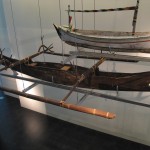

- Resources Start here
- Southeast Asia
- Philippines
- Timor Leste
- Peripheral Southeast Asia
- Architecture
- Bones and Burials
- Intangible Cultural Heritage
- Anthropology
- Bioarchaeology
- General Archaeology
- Metallurgy and Metalworking
- Paleontology
- Underwater Archaeology
- Zooarchaeology
- Christianity
- Disaster Risk Management
- Archaeological Tourism in Southeast Asia
- Online Lecture Library
- Journals and Papers
- Data Repositories and References
- Archaeological Projects in Southeast Asia
- Conferences
- Laws and Legislation
- Archaeology Education in Southeast Asia
- Digital Tools and Software
- Virtual Archaeology
- Exhibitions
- Unesco World Heritage
- Terms of Use
- Privacy Policy

Related Posts
![how did humans travel to australia [Paper] Prehistoric Stone Ornaments from Phromtin Tai, Central Thailand: New Perspectives on Workshop Traditions through the Study of Drilling Methods](https://y8b3h6z9.rocketcdn.me/wp-content/uploads/2024/04/DSC9074_20221115_1049160700-scaled.jpg)
[Paper] Prehistoric Stone Ornaments from Phromtin Tai, Central Thailand: New Perspectives on Workshop Traditions through the Study of Drilling Methods

[Paper] The Hoabinhian technocomplex in southwest China: Preliminary report on new discoveries in recent decades

[Paper] Archaeological and molecular evidence for ancient chickens in Central Asia

[Video] Understanding An Ancient Amputation with Dr. Melandri Vlok
Popular this week.
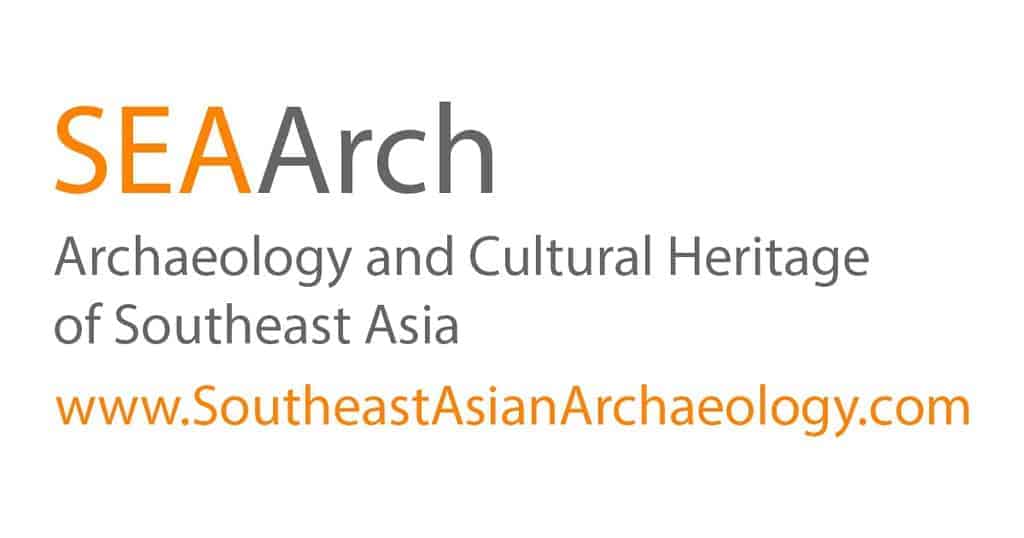
Negritos or Malays: Who are the original inhabitants of the Philippines?
Another wave of dispute as academic called out for misinformation on malacca, stone jars of northeast india with a possible cultural link to laos, [free book] quaternary palaeontology and archaeology of sumatra, cambodia’s temples beyond angkor wat.
If you found this site useful, you can help support it by buying me a coffee!
Home » Indonesia » How did the first humans migrate into Australia?
How did the first humans migrate into Australia?

via various sources including ANU Media, the Guardian and the Journal of Human Evolution: A new paper in the Journal of Human Evolution models the “least-cost pathways” humans would have taken through Island Southeast Asia in order to reach Australia, offering a predictive insight into areas of high archaeological potential.
Least-cost pathway models indicate northern human dispersal from Sunda to Sahul Kealy et al., https://doi.org/10.1016/j.jhevol.2018.10.003
Archaeological records from Australia provide the earliest, indirect evidence for maritime crossings by early modern humans, as the islands to the north-west of the continent (Wallacea) have never been connected to the mainland. Suggested in 1977 by Joseph B. Birdsell, the two main routes from Sunda (mainland Southeast Asia) to Sahul (Australia-New Guinea), still in debate today, are a northern route through Sulawesi with a landing in New Guinea, or a southern route through Bali, Timor and thence landing in northern Australia. Here we construct least-cost pathway models of human dispersal from Sunda to Sahul at 65 ka and 70 ka by extending previous out-of-Africa least-cost models through the digitization of these routes. We recover overwhelming support for a northern route into Sahul, with a landing location on present-day Misool Island. Minimal support is also recovered for the southern route at 70 ka, with a possible crossing to Sahul from eastern Timor. Review of archaeological records on the Wallacean islands crossed by our northern route indicate a dearth of archaeological research in this region. Meanwhile, the comparatively better studied southern islands still lack any archaeological dates comparable to those known for initial occupation in Sunda and Sahul. Based on our model results we suggest Misool Island as the initial landing site for early modern humans on Sahul and recommend a future focus on archaeological fieldwork in the northern Wallacean islands.
- First humans to reach Australia likely island-hopped to New Guinea then walked – study | The Guardian, 30 September 2018
Subscribe to the weekly Southeast Asian Archaeology news digest
Latest books, the following are affiliate links for which i may earn a commission if you click and make a purchase. click here for more books about southeast asian archaeology..
Last update on 2024-04-10 / Affiliate links / Images from Amazon Product Advertising API
Leave a Reply Cancel reply
This site uses Akismet to reduce spam. Learn how your comment data is processed .
Navigate Site

All the news in one weekly email
Historical ties between Indonesia and Australia's top-end illuminated after photo discovery unravels a family mystery
A young man stands on a beach, watching the water.
Behind him is everything he's ever known – his country, his family, the rhythms of life on a small, isolated island.
Ahead? A hazy horizon, and a foreign boat crew about to sail beyond it.
As the tide begins to turn, he has a big decision to make.
Soon he is on the boat, wind whipping his curly dark hair, on a historic, international voyage that's being pieced together for the first time in more than 150 years.
This is a personal story of heartache, lost love, and splintered families.
But it is also sweeping in scale, illuminating a little-known era in the history of the Australian continent, when the first waves of international travel created a web of cross-cultural romance and relations.
"The man in the photos is Dirrikaya, and he was my great-grandfather," says Sylvia Tkac.
"He went overseas and had a family we've never met — and he wasn't the only one.
"So it's like a love story — and it's wild."
WARNING: Aboriginal and Torres Strait Islander people are advised that this article contains images of people who have died.
A photo mystery
The identification of Dirrikaya brings full circle a history mystery triggered by the discovery of a trove of black and white photos in a dusty Italian museum collection in 2011.
The portraits were taken in the Indonesian port city of Makassar in the 1870s and show a group of Indigenous people from Australia — including a young child.
The photos raised many questions.
Who were the young men, how did they get to South-East Asia, and how many other First Nations people moved overseas prior to contact with British colonisers?
Ms Tkac was at her home at Groote Eylandt on Australia's remote north coast when she first saw the photos broadcast on ABC News in early 2023.
"My cousin Amos rang me and goes, 'Guess what, those photos on ABC are our great-grandfather Dirrikaya.'
"I was so shocked!" she exclaims.
"And he started telling me about how our ancestors had sailed away to Indonesia with the visiting fishermen."
It is impossible to prove beyond doubt that the man in the photos is Dirrikaya.
But local families say the body markings, physical resemblance and oral history make for a compelling case.
Who was Dirrikaya?
According to family lore, Dirrikaya was a slender teenager when he made the fateful decision to sail overseas.
He was an Anindilyakwa man, who bore scars etched in flesh during coming-of-age ceremonies.
"That scarification, only the men have that, not the women," explains great-grandson Amos Wurramarrba.
"He would have been a strong cultural man."
Dirrikaya's ancestors are believed to have lived on their island archipelago for thousands of years before the Makassans arrived.
Anindilyakwa country covers several islands on the eastern edge of Arnhem Land, a mere 600 kilometres from the Indonesian archipelago.
In the 1600s and 1700s, as the trading of spices and seafood escalated across the Asia-Pacific region, things began to change for tribes across the northern coast.
Waves of Asian fishing crews from Makassar — the Dutch-run port of the eastern Indonesian island of Sulawesi — began to arrive. Sailing south with the trade winds, they set up camps on local beaches for months to harvest sea cucumber on an industrial scale.
It appears they were cautiously welcomed by local Aboriginal tribes who recognised a mutually beneficial arrangement.
"We gave the Makassans permission to get pearls and trepang [sea cucumber] and in return, they traded cloth and rice and knives and hooks," Ms Tkac explains.
Over the decades the visits became more regular.
Indonesian words were incorporated into local dialects, and the arrival of the Makassan boats woven into ceremonial dance and rock art still scattered in caves and cliffs.
Romances formed between the visiting fishermen and local women, resulting in babies and complex, cross-cultural family trees.
And, at some point, Aboriginal people started moving overseas with the visiting fishermen.
Among them was Dirrikaya.
'He wanted adventure'
It's thought the men and women who boarded the boats did so voluntarily.
"Think about it – you're on this isolated island, and you're offered the chance to sail away – I think he wanted to go," Ms Tkac says.
"I think Dirrikaya wanted adventure."
Mr Wurramarrba agrees.
"It feels good to be here, in my great-grandfather's footprints," he says, gazing out across the wind-rippled bay from where Dirrikaya departed.
"I think he and the other men that left with him wanted excitement and they wanted to travel.
"But the problem was Dirrikaya didn't tell his family where he was going, so they thought he must have died and were wailing for him."
According to oral history, a total of four Anindilyakwa men set sail with the foreign crew.
Not long after, the boat docked in the bustling port city of Makassar.
Clues buried in historic documents
Little is known about Dirrikaya's years in Indonesia.
But there's growing evidence that a significant number of Aboriginal people were living there at the time.
In 1824 the Dutch governor-general wrote in his journal of seeing Aboriginal people from Australia walking the streets.
"They are very black, tall in stature, with curly hair, long thin legs, and, in general, are quite well built."
But the black and white photos are the only visual evidence that has surfaced of their presence during this period.
The studio portraits were taken in Makassar in 1873 by Italian naturalist Odoardo Beccari.
At the time he was travelling through South-East Asia, documenting the mix of people and cultures he encountered.
The same year he took the photos, Mr Beccari wrote in his journal:
"To Makassar come some [boats] every year from northern Australia … and Indigenous Australians are not uncommon in Makassar where you see them moving about in the streets."
His photographs remained buried in the archives of the Pigorini Museum in Rome until 2011 , when they were unearthed by University of Western Australia Professor Jane Lydon.
They're an invaluable piece of historical evidence, according to Monash University Professor Lynette Russell.
She's heading an international research project called Global Encounters, which is investigating early contacts on the Australian continent .
"This is a story that most people have no idea about, but there is no doubt that Aboriginal people came to Makassar and stayed and had families," she says.
"Some voyaged back to Australia, but others did not.
"I suspect the scale of the movement is probably larger than what we first thought."
The scenario challenges Australia's national origin story of a continent of landlocked people living in isolation for tens of thousands of years.
Professor Russell — who has Wotjobaluk heritage herself — says the migration north shows more than a sense of adventure.
"I think the Aboriginal people who decided to join the Makassan fleets showed extraordinary agency and entrepreneurship," she reflects.
"There was obviously also a network of friendships and relationships that developed.
"I think it's extremely likely that there are descendants of Aboriginal people here in Makassar, and descendants of Makassan sailors in Australia."
Family connection lost
According to family history, Dirrikaya lived in Indonesia for several years and had a wife and children.
But the pull of home proved too strong.
"He decided he needed to come home to see his country again and his parents … so he sailed back to Australia," explains Ms Tkac.
It was a tearful reunion. Dirrikaya was back from the dead, and telling strange stories about a land far, far away.
But one thing had changed.
"He had two gold teeth!" reveals Ms Tkac.
"They sparkled in the sun. The family couldn't believe it."
But for Dirrikaya, amid the elation, there was grief.
He had left his wife and children across the ocean.
"He was hoping they would come to see him on the Makassan boats," Ms Tkac explains.
"But he watched the horizon every year when they came, and his wife and children were never there ... he cried for them."
A few years later came a decision that shut down any chance of contact.
As British settlements expanded across northern Australia, resistance to foreign visitors grew, and Australian authorities shut down the Asian trepang trade in 1907 .
"It was very sad for our old people," says Mr Wurramarrba.
"They didn't understand what was going on, and why the Indonesians stopped coming."
"Lots of families were torn apart."
Dirrikaya went on to have a wife and children back at his home on Groote Eylandt, but he never forgot his family in Makassar.
The Wurramarrba family is now on a mission to try to locate Dirrikaya's descendants in Indonesia.
"They're our family," Ms Tkac reflects.
"Who are they, where are they — I want to meet them."
And they are not alone.
Across the ocean, another family searching
The historic port precinct of Makassar is as viscerally different from Groote Eylandt as can be imagined.
A mosque looms over the glistening water.
In the bustling backstreets of Losari Beach vendors crowd the pavement, hustling to sell smokes and sweet biscuits.
Here, the Aboriginal families from the vast southern land would have stepped off fishing boats and surveyed the scene.
Professor Russell is wandering the laneways tucked behind the waterfront.
"What an overwhelming experience it must have been for them," she marvels.
"To be in this new place, full of different languages and food and smells – I think it's a universal feeling, that desire for adventure and to be outside of your comfort zone."
There are accounts of Aboriginal men living in homes in the area as trusted employees of well-to-do fishing captains.
And buried in the busy streets is a family with their own extraordinary personal story to tell.
Kaharuddin Lewa, who is known as Pak Kahar, and his family are also searching for long-lost relatives.
His great-grandfather was a Makassan fishing captain named Using Daeng Rangka, who had an Aboriginal wife and children during his decades sailing to Australia.
"He liked and respected the Aboriginal people," Pak Kahar explains.
"He wanted to help them, and share with them his Islamic religion."
The family knows that Captain Rangka, an experienced trepang fisherman of the era, had journeyed to Australia dozens of times between 1855 and 1907.
And there's evidence he partnered with a Yolngu woman in Arnhem Land and had several children.
Pak Kahar unfurls a carefully drawn genealogical map on the living room table, as his cigarette smoulders in a silver ashtray nearby.
"We think that they had four children in Australia – two boys and two girls ," he says.
But contact was lost in the early 1900s when the fishery wound up.
Now the family wants to find their relatives in Australia and meet them.
"I really want to meet them, to complete the family tree with my Aboriginal family," Pak Kahar says.
"I will welcome them with joy and happiness, and gather everyone together.
"I want to get to know them closely, so our family ties grow stronger through the generations."
Their situation is a mirror image of the Wurramarrba family in remote northern Australia.
Two families, with lineage cut off by ocean and history, anxious to reconnect with relatives before the knowledge of what occurred on those remote northern beaches is lost forever.
The physical links to the era are fragile and vanishing.
Every year, the graves of Makassan trepang ship captains weather and crumble, while one historic ship captain's house — rumoured to be made from Australian timber — was recently demolished.
A rare recording revealed
There are no written records of Dirrikaya's departure and eventual return — the story has been passed down four generations of the Wurramarrba family by word of mouth.
But recently a rare audio recording from more than half a century ago was found.
It contains Dirrikaya's story as told by his eldest son Charlie Galiawa Wurramarrba .
Ms Tkac plays the tape for her 78-year-old mother Margaret, who is Charlie's daughter.
Unmute to watch the emotional moment when the Anindilyakwa matriarch hears her father's voice for the first time since he died in 1978.
Charlie's voice is melodic and calm; a fragile wire connecting two eras.
"Long ago my father told me his story," the old man tells the interviewer. "He went away when he was young, while he was single, before he grew up. "Wanabadi the Makassan took him, took him away, and he went to their country. "My father was away for four years."
The recording is significant as it helps verify the accuracy of the narrative handed down over several generations.
Search for traces of Dirrikaya
Mr Wurramarrba has taken the family to a remote beach on an unusual quest — they're trying to locate Dirrikaya's remains.
After returning from his overseas adventure, Dirrikaya married a local woman and had several children.
He died an old man and was laid to rest at a beach along the western edge of Groote Eylandt.
Crucially, the family believes the gold teeth he had implanted in Makassar were buried with him.
Could they be the final and only physical evidence of his trip?
"When he died, his remains would have been put up in a tree and dried out," Mr Wurramarrba explains.
"Then the bones were wrapped in paperbark and tucked away where they were safe."
But the exact site is hard to find. Over the decades the landscape has changed and memories have faded.
But as she walks along the beach, Dirrikaya's closest living relative — Margaret Wurramarrba – has a flashback.
The frail matriarch becomes animated as she describes a memory from adolescence.
"I was here at the beach collecting berries, and I suddenly saw the gold teeth!" she exclaims.
"They were in a bower-bird's nest. The bird had found the gold teeth.
"I told my father and he told me to return them to where my grandfather was buried, under a big tree."
It's a tantalising lead, but after several hours of surveying the coastline, the search is called off.
The sun is starting to set, and the location of Dirrikaya's gold teeth — for now — must remain a mystery.
The family is determined not to give up.
DNA testing remains a possibility to prove a connection to relatives in Makassar.
But first, the search would need to be narrowed to a family group or community linked to Dirrikaya in a city of more than 2 million people.
"Seeing Dirrikaya's face for the first time lit something up inside me," Ms Tkac reflects.
"I want to know more now. What happened to our family in Indonesia, and can I meet them?
"His story has been passed down, it is our family's story, and we need to do our bit to keep it alive."
- Images and video by Paul Bell, Mitchell Woolnough and Erin Parke
- Graphics by Shakira Wilson and Gabrielle Flood
- Production by Fran Rimrod and Kit Mochan
Editorial note: Images of deceased people have been published with permission.
Watch more of The Lost Families in the latest episode of Compass on Sunday, March 31 at 6:30pm on ABC TV or stream any time on ABC iview.
- X (formerly Twitter)
Related Stories
Proof of mystery settlement of aboriginal australians and indonesians found in an italian library.
Tip-offs narrow search for descendants of Australia's mysterious overseas colony
- Academic Research
- Ancient History
- Colonialism
- Indigenous (Other Peoples)
- Indigenous Culture
- International Law
- Photography
- Race Relations
- Stolen Generations
- International edition
- Australia edition
- Europe edition

Great Barrier Reef discovery overturns belief Aboriginal Australians did not make pottery, archaeologists say
Paper dates 82 pottery pieces found in single dig site at between 3,000 and 2,000 years old and finds they were most likely made by Aboriginal people
- Follow our Australia news live blog for latest updates
- Get our morning and afternoon news emails , free app or daily news podcast
Groundbreaking archaeological research may have upended the longstanding belief that Aboriginal Australians did not make pottery.
A paper published in the Quaternary Science Reviews on Wednesday details the finding of 82 pottery pieces from a single dig site on a Great Barrier Reef island, dates them at between 3,000 and 2,000 years old and determines that the pots were most likely made by Aboriginal people using locally sourced clay and temper.
The pieces are the oldest securely dated pottery ever discovered in Australia and weave Indigenous Australians into an ocean-going network of people in Papua New Guinea, the Torres Strait and Pacific Islands who formed a “community of cultures across the Coral Sea”, the paper finds. Fragments of pottery have also been found on the Torres Strait.
The archaeologists say the finds open “a new chapter in Australian, Melanesian and Pacific archaeology”.

The Walmbaar Aboriginal Corporation chairperson, Kenneth McLean, is a Dingaal clan member and traditional owner of the group of islands on which the pottery was unearthed.
“For our elders Jiigurru was always a sacred place,” McLean said. “It was always a place of trading and ceremony.”
James Cook University distinguished professor Sean Ulm, who co-led the dig alongside Monash University’s Prof Ian McNiven and with the Dingaal and Ngurrumungu communities, says its finds not only overturn notions about Aboriginal people and pottery but a number of “very common tropes” about Indigenous Australians.
One is that they were all isolated from the rest of the world. Another regards the simplicity of Aboriginal watercraft.
The chain of islands of Jiigurru – of which the 10 square kilometre Lizard Island is the largest – surround a lagoon about 33km off Cape Flattery.
The 2.4-metre deep dig unearthed evidence of continuous occupation going back more than 6,000 years on the islands, cut off from the mainland by sea level rise at least 10,000 years ago.
McLean believes that his ancestors would have used the clay pots to carry resources such as water and shellfish on the long canoe voyages to the islands.
“Holding the pieces of pottery that were locally made, on Country, that was feeling my ancestors’ presence,” he said.
“It was an emotional moment, holding something that was ancient.”
Much, though, remains to be learned about how the pots were made and appeared. The average size of the sherds is less than 2cm – too small and fragmented to reveal much of their original form and function.
So momentous a story told by such tiny pieces of worked earth explains why the research took years to reach publication, Ulm says.
The dig began in mid 2017 and ended 14 months later. But its findings would challenge a view widely held among academics since fragments of pottery were first spotted on Jiigurru by a holidaying archeologist from New Zealand while he snorkelled the shallow lagoon in 2006.
Attempts to date those pottery pieces were inconclusive, though they were interpreted by many as direct evidence of the presence of Lapita people in Australia.
From the islands of eastern Papua New Guinea and over the span of a few centuries, the Lapita and their descendants settled vast swathes of the remote Oceania, taking pigs, dogs and chickens, taro and breadfruit, and their distinctive pottery to the Solomon Islands and eastwards across the Pacific into Vanuatu, New Caledonia, Fiji, Tonga and Samoa.
Ulm’s paper describes it as “one of humanity’s great maritime settlement accomplishments”.
But when Ulm and his colleagues went looking for more pottery pieces using the kind of methodical dig that could shed light on who made the Jiigurru pottery and when, they found none of the telltale signs – chicken bones or traces of banana – that would suggest Lapita occupation. Instead the shellfish and fish bones of the midden site spoke of continuous Indigenous occupation. And none of the ceramic sherds bore the hallmark designs of Lapita potters.
The find begs the question of why pottery pieces weren’t found on the site after about 2,000 years ago, though seasonal occupation continued. That, Ulm says, is a question which cannot be answered from one dig site and will require more research to unravel.
MacLean, too, hopes the research will encourage further collaboration between Indigenous communities and archeologists that will “find more of the ancient artifacts that could rewrite Australia’s ancient history”.

University of Southern Queensland professor Bryce Barker, who was not involved in the study, says it “certainly is very significant” and an “exemplary piece of research”.
“The science in that paper is exemplary – you can’t fault the science,” he said. “I don’t think there is any question that there is pottery there at 3,000.”
But the claim that Aboriginal people made the pottery, he says, is “a little bit contentious”.
“Perhaps the more parsimonious explanation for why that pottery is on Lizard Island is that it is part of that trade and interaction with those people from the north, rather than it being something that Aboriginal people manufactured,” he said.
The researchers involved argue that the ancient pottery of the Great Barrier Reef “points to the likelihood” of more remains, perhaps including Lapita, scattered about “the vast and archaeologically unknown north-east Queensland coastline”.
“To me, that’s what’s exciting about the find, that it’s a little glimpse into the extraordinary knowledge that we are yet to unfold about the deep history of this country,” Ulm said.
“If one excavation of one metre by one metre can tell us all these ‘new things’, what does the rest of the coastline have to teach us?”
- Indigenous Australians
- Archaeology
Most viewed
- Travel Updates
- Travel Stories
Why cruise line Norwegian Dawn did the right thing by ditching passengers
Eight people have accused Norwegian Cruise Line of abandoning them. Now, one cruiser said the ship’s captain did the right thing.

Cruise line’s huge move in Australia

‘Fail’: Aussie destination is being ‘boycotted’

Aussies horrified at American’s milo act
Eight people have accused Norwegian Cruise Line (NCL) of abandoning them on a tiny island in Africa after a private tour ran late and the group missed the embarkation cut-off time.
Four of the group are elderly and another is pregnant , and though the ship was still at anchor, they were denied boarding.
The ship, the Norwegian Dawn, set sail without them – and it was right to do so.

Once, I was late to check in for a flight. I jumped out of the taxi, sprinted to the counter (which is no mean feat when you’re hauling luggage) and arrived at the desk sweating bullets, prepared to get on my knees and grovel if it meant I’d be allowed through. I began to tell my sob story to the lady at the desk, heart hammering and lungs gasping for air, when she politely interrupted and shook her head.
In the nicest way possible, she said this: “Stiff bickies.” (OK yes, I’ve paraphrased.)
Sure, the plane was still at the airport, no more than a few hundred metres from where I was standing. However, the luggage had already been loaded, the manifest had already been finalised, and the other passengers were already boarding. There was no way they were going to let me board, nor should they have.

You see, I had been on a whale-watching tour about two-and-a-half hours south of the airport – hey, it was my last day, I wanted to make it count. I planned it to perfection, except for one detail: we spotted a playful pod right at the very end, so the captain offered to give us some bonus time to enjoy the view.
With one eye on the magnificent mammals, and another on my watch, I held on to a flicker of hope that I might make it. I jumped on the bus back to town, flagged down a cab, and asked the driver to hurry. I launched out of the car like a 100m sprinter launches out of starting blocks and ran into the terminal.
Alas, my proverbial ship had sailed.
Was it a bummer? Absolutely. But imagine delaying the other 158-or-so passengers scheduled to depart on the Boeing 737, asking the crew to extend their shifts, or holding the plane and disrupting airport traffic … all so little old me could drop off my bags, scurry through security, and find my gate.
Imagine the awkwardness if I stepped onto that plane. What do you say? “Sorry guys, my bad, lol.”
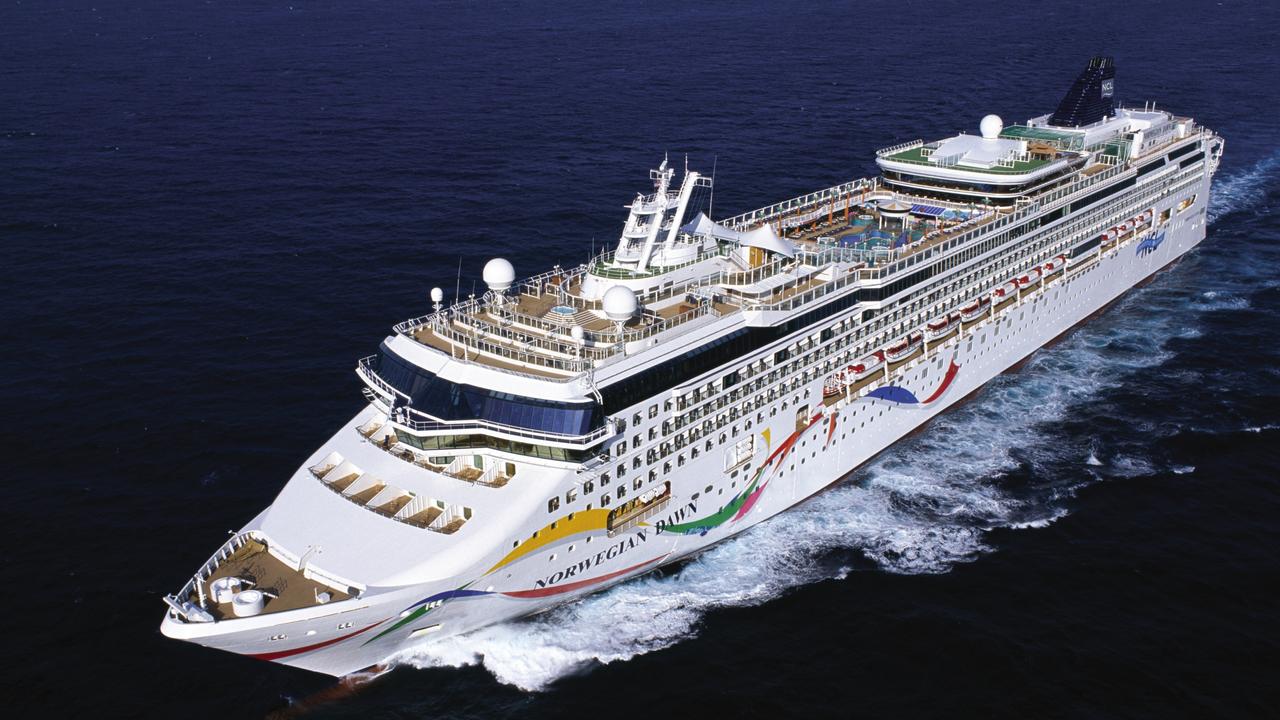
That doesn’t even scratch the surface of a cruise ship’s operations. Norwegian Dawn can accommodate 3372 people – 2340 passengers and 1032 crew – and this group of eight expected it to wait?
A ship’s departure time isn’t exactly a mystery.
I sailed on Norwegian Dawn in February and the departure time was published in NCL’s Freestyle Daily newsletter the night before and announced over the loudspeaker multiple times in the morning. It was also posted on signs at the doors where guests disembark.
The golden rule is clear: Make sure you’re back on time, or the ship may sail without you.
So what do you do if you’re left behind? Generally there are two options: either catch up with the ship at a later port or head home. If you’re lucky, you’ll have brought your essentials with you – your passport, phone, credit card, and medication – because all of your belongings will stay on board until the end.
Please don’t get me wrong, of course I’m sympathetic to the distress of those who were left in a foreign country without the safety of the ship. It would be scary and stressful to figure out next steps, especially for the members of the group with higher needs, and disappointing to miss out on their holidays.
However, the unfortunate reality is that ships can’t always wait.

Private tours are a whole separate issue, because while the ship will wait for official tours – those which have been organised by the cruise ship operator – to return, all bets are off for passengers taking their shore excursions into their own hands. Unofficial tours can be slightly cheaper than those on the ship’s itinerary, with slightly more availability, so they can be attractive. However, while operators will do their best to stick to scheduled times, all bets are off once you board that bus and leave the port.
Think of it like booking multiple legs of a trip with different airlines. They’re not in the same network, they don’t owe each other anything, and they can’t guarantee that you’ll make your connection. Say the bus breaks down. Maybe someone wanders off and takes ages to find. Perhaps the group lingers over a delicious lunch. Someone might need to stop at an ATM or a loo. You could get stuck in traffic. Or maybe your tour will be like mine and you’ll see something incredible that simply makes you want to pause.

More Coverage

And so, eight passengers were left in São Tomé and Príncipe, Africa’s second-smallest country.
“While this is a very unfortunate situation, guests are responsible for ensuring they return to the ship at the published time,” NCL said in a statement, adding that it is communicating with the guests about their next steps. It’s harsh but fair, especially since the other 3364 (or so) people on board got it right.
Kirrily Schwarz recently sailed on Norwegian Dawn as a guest of Norwegian Cruise Line.
Cruising has become a big deal over the past few years, even among Gen Z-ers, which is why this liner has made a big move in Australia.
One of Australia’s most popular islands has made a move that’s left Aussies furious with some even vowing to “boycott” the hotspot.
An American social media star promises he is a Milo pro now after being absolutely roasted by Aussies for making this hilarious mistake.
- Search Please fill out this field.
- Manage Your Subscription
- Give a Gift Subscription
- Newsletters
- Sweepstakes
Rumors of King Charles Touring Australia amid Cancer Re-Emerge as Source Says Nothing Has Been Ruled Out
The King's nephew recently shared that the monarch is "hugely frustrated" that he "do everything that he wants to be able to do" amid cancer treatment
Stephanie Petit is a Royals Editor, Writer and Reporter at PEOPLE.
:max_bytes(150000):strip_icc():format(webp)/Stephanie-13-258c05f276a7429a88ccccf5dd0c2103.jpg)
ADRIAN DENNIS/AFP via Getty
King Charles ' first trip Down Under as monarch is still up in the air amid his cancer treatment .
After Australian Prime Minister Anthony Albanese said last month that the country is "preparing for a possible visit from His Majesty The King to Australia later this year," new reports say the King, 75, is prepping for the visit to occur this fall.
A royal source guides that nothing has been ruled out or in as they look ahead to the fall and planning continues for future engagements, but it is all subject to medical advice and there may be adaptations where necessary at the time. Overseas visits would not and could not be confirmed until nearer the time.
Before news of his cancer diagnosis, King Charles was widely expected to travel to Australia around the time of the Commonwealth Heads of Government Meeting (CHOGM), which is being held in Samoa and scheduled to kick off on Oct. 24. Since Australia is a Commonwealth realm, they recognize the British monarch as their head of state.
"The King has shown his compassion for Australians affected by recent natural disasters, just as Australians have shown compassion and support for the King following his cancer diagnosis," Albanese said last month. "The King, Queen and members of the royal family are always welcome in Australia. My government is engaging with states and territories on options for a possible royal visit."
Chris Jackson/Getty Images
A royal source recently told PEOPLE that the monarch and his team are thinking about a summer schedule amid "amplified confidence" in light of the sophisticated cancer treatment he is receiving, adding that the King is "positive" and his doctors "are optimistic."
While he's continued to work behind the scenes, King Charles' royal engagements have been restricted to small numbers of people since the palace revealed his cancer diagnosis on Feb. 5, However, towards the summer when the risk of airborne illnesses eases, larger events could take place outside – such as Trooping the Colour , the annual public celebration of the monarch's birthday set for June 15 this year.
"One thing that has been wholly undiminished is his appetite for work," the royal source added.
Mark Cuthbert/UK Press via Getty
Can't get enough of PEOPLE's Royals coverage? Sign up for our free Royals newsletter to get the latest updates on Kate Middleton, Meghan Markle and more!
Peter Phillips , the King's nephew, recently said the monarch is "very keen to get back to a form of normality."
“I think, ultimately, he's hugely frustrated . He's frustrated that he can't get on and do everything that he wants to be able to do," Princess Anne's son said on Sky News Australia 's The Royal Report. “But he is very pragmatic, [and] he understands that there's a period of time that he really needs to focus on himself."
HOLLIE ADAMS/POOL/AFP via Getty Images
In a promising sign of his progress, King Charles made his first major public appearance since his cancer news on Easter to attend church with members of the royal family. After the mass at St. George's Chapel in Windsor Castle, the monarch and Queen Camilla briefly greeted members of the public on a surprise walkabout.
"Get well soon, Your Majesty," a woman said in a video shared to X by Rebecca English of the Daily Mail , prompting the King to reply, " I'm doing my best! "
Related Articles
Here’s How the 2024 Solar Eclipse Will Impact Air Travel
Meghna Maharishi and Elizabeth Casolo, Skift
April 4th, 2024 at 8:51 AM EDT
The solar eclipse will have a minimal impact on air travel, but airlines are operating a slew of flights that will give flyers a special view of the once-in-a-lifetime event.
Leading up to April 8, cities in the eclipse’s path of totality prepare for an influx of tourists. But, even with some extra traffic for airports and airlines, operations likely won’t look too different.
Skift named April’s eclipse “this year’s top travel phenomenon,” with cities such as Buffalo, Indianapolis, and Dallas gearing up for the big day. Some airlines offered specialized experiences for eclipse travel, and tourism bureaus coordinated events to celebrate the evening.
With these plans in place, those flying in may wonder about what to expect in the air.
Will There Be Any Travel Disruptions?
It’s possible. The Federal Aviation Administration warned of potentially higher traffic at airports in the eclipse’s path.
“Traffic should anticipate delays during peak traffic periods,” the FAA said in a statement .
Some airports did not express concern about incoming travelers but still plan to take precautions. The Niagara Frontier Transportation Authority operates the Niagara Falls International Airport and Buffalo Niagara International Airport, two airports on the eclipse path. NFTA Aviation Deputy Director Russell Stark said air traffic control is preparing for more traffic, but the airport itself has not observed more traffic than usual.
“We have not seen any increase in the traveling public coming via airplane,” Stark said. He expressed concern about the roadways beyond the airport and does not have enough information to know if air traffic from other airports would impact arrivals or departures.
A spokesperson from Dallas Fort Worth International Airport also did not have clarity on the airport traffic, but “the airport’s rental car partners… expect to have the busiest days on record for car rentals around the time of the eclipse.”
Other than the special eclipse flights run by certain airlines, Indianapolis International Airport does not foresee a big change in operations. The airport estimates the highest traffic period will be April 9, as people leave the morning after the eclipse.
“Nearly 20% of our traffic on Tuesday, April 9, will be departing by 7 a.m.” said Megan Carrico, director of public affairs for the Indianapolis Airport Authority.
So, while there may be more air traffic congestion in the hours after the eclipse, expect busier roads in cities along the eclipse’s path, as well.
What Are Airports Doing to Prepare for the Eclipse?
The FAA advised airports to minimize procedures that could take attention away from potential traffic. The agency said pilot training operations at airports may either be “extremely limited” or “possibly prohibited” during the eclipse.
“The bottom line is it’s ‘operations normal’ around here with a few minor changes on our part,” Stark said. Stark emphasized that contractors working on projects around the airport need to prioritize eclipse safety, something that’s been incorporated into their daily briefings. NFTA employees also have access to eclipse glasses in case they work outside during that time.
Carrico said Indianapolis International Airport will apply its experience handling traffic from major sporting events during the eclipse. The airport also partnered with art students and Visit Indy to make decorative posters commemorating the event.
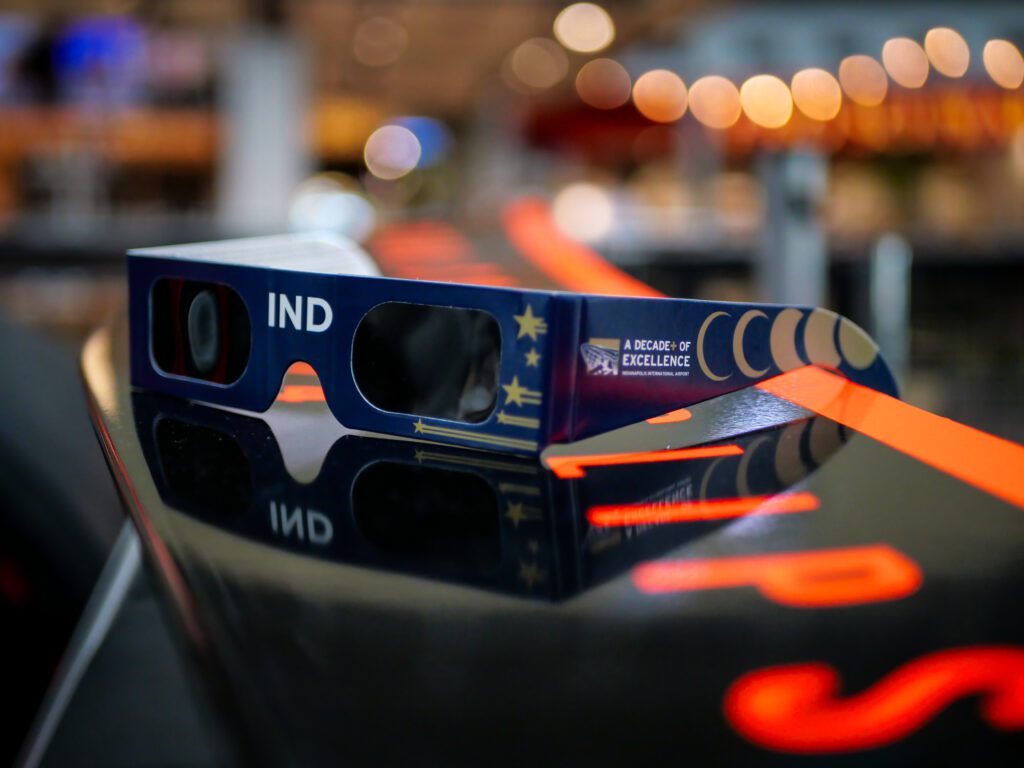
Is It Safe to Fly in the Middle of a Solar Eclipse?
Yes. Whenever a plane is in the path of a solar eclipse, the sky will look dark for a few minutes. A solar eclipse doesn’t interfere with an airline’s operations — it’s almost no different than flying in the night, said Dr. Frederic Bertley, the CEO of the Center of Science and Industry, a museum in Columbus, Ohio.
“It shouldn’t impact how the aircraft itself will fly in terms of solar radiation or flares or darkening of the skies,” Bertley said.
A solar eclipse wouldn’t impact a pilot’s ability to fly an aircraft, either.
“It’s really from an aircraft and a pilot’s viewpoint,” Bertley said. “It’s just a matter of light versus less light. That’s all it is.”
The Air Line Pilots Association said pilots could expect to see skies as dark as night if they are flying in the path of totality. Otherwise, travelers on flights further away from the path may see a dusky sky.
Can I Experience the Eclipse From a Plane?
Yes. While many may purchase solar eclipse sunglasses to view the event from the ground up, witnessing it on a plane can also have its benefits.
The main advantage of viewing an eclipse from a plane is that it’s above cloud cover, which could offer the clearest view. Bertley said around 40% to 60% of the country that’s in the path of totality will most likely have some cloud cover.
And while someone on the ground might see an eclipse for a mere two to three minutes, a passenger on a plane in the path of totality could possibly view the eclipse for as long as six-and-a-half minutes.
This is because a plane flies at around 500 miles per hour while the eclipse moves at 1,000 miles per hour, which essentially gives passengers the ability to see 50% more of the eclipse, Bertley said.
However, for passengers on flights that are in the path of the eclipse, where you sit on the plane to view the eclipse matters. For example, if a traveler is on a flight leaving from Texas that goes along the path of totality from west to east, that traveler would need to sit on the right side of the plane to view the eclipse. Passengers sitting on the left side in this instance won’t see the eclipse. According to a spokesperson at Delta Air Lines, though, the airline is working with the FAA to approve S-turns on its special path-of-totality flights, ensuring both sides of the plane can view the eclipse.
American Airlines also said it was working with the FAA to ensure smooth operations and was anticipating increased air traffic at locations in or near the path of totality.
Delta offered a special flight from Austin to Detroit that covers the path of totality. After this flight sold out in under 24 hours, Delta started offering a flight from Dallas Fort Worth to Detroit . United Airlines is offering a slew of flights from Chicago and Houston that will allow travelers to catch a glimpse of the event. And Southwest Airlines has flights departing from Dallas Love Field, Austin, and St. Louis in the eclipse’s path.
The Daily Newsletter
Our daily coverage of the global travel industry. Written by editors and analysts from across Skift’s brands.
Have a confidential tip for Skift? Get in touch
Tags: ALPA , austin , dallas/fort worth international airport , delta air lines , faa , solar eclipse , southwest airlines , united airlines
- Skip to main content
- Keyboard shortcuts for audio player

Solar eclipse 2024: Follow the path of totality
Thinking of taking a last-minute drive to see the eclipse here's what to know.

Geoff Brumfiel

RV traffic sits at a standstill along a two-lane road near Madras, Ore., a few days before the 2017 total solar eclipse. Experts say traffic could be heavy, but eclipse watchers shouldn't necessarily be deterred. AFP Contributor/AFP via Getty Images hide caption
RV traffic sits at a standstill along a two-lane road near Madras, Ore., a few days before the 2017 total solar eclipse. Experts say traffic could be heavy, but eclipse watchers shouldn't necessarily be deterred.
NASA says that roughly 31.6 million people live in the path of this year's total solar eclipse, and a little under half of the U.S. population lives within 200 miles driving distance of the path of totality .
That could mean many millions of Americans will hit the road to get a better view on April 8. If you're still pondering whether or not you want to make the journey, here's what to consider.
Have some destinations in mind, and check the weather and cloud cover forecasts in advance
It's a good idea to scout out one or more locations within driving distance, so that you have some flexibility if traffic or weather is threatening your plans, says Jonathan Upchurch, a professor emeritus of civil engineering at Arizona State University who has studied travel around solar eclipses.
There are several interactive tools that show the path of totality, including Eclipse2024.org and the National Solar Observatory . You can use them to figure out what sites might work best for you.
In terms of weather, check not just the weather forecast, but also the cloud cover forecast. Some websites, such as Windy.com will predict cloud cover ahead of time, giving you a sense of whether you'll actually be able to see the eclipse in all its glory.

Everything you need to know about solar eclipse glasses before April 8
During the total solar eclipse in 2017, Upchurch says he chose to go to Idaho "because there were some great chances of having sunny skies, and I had the opportunity to be nimble and relocate if I wanted to."
Before driving into the path of totality, make sure your gas tank is full and that you've got everything you need
During the last total solar eclipse in 2017, it's estimated some 5 million people took to the roads, and those numbers will potentially be much higher this year.
Given all that, Upchurch says it's important to make sure you're taking what you need into the path of totality. You should make sure your car is gassed or charged up, and that you have plenty of snacks and water with you in case you get stranded for a while, especially when trying to leave.

Solar Eclipse 2024: Totality stretches from Texas to Maine
Simple tips to safely photograph the eclipse with your cellphone.
Also don't forget to bring eclipse glasses, which must be worn anytime you're looking at the sun, except for the few minutes when it is completely blocked by the moon.
Some state emergency planners also recommend bringing a paper map or road atlas in case cellular networks become overloaded with visitors seeking directions from their phones.

Don't forget your eclipse glasses everyone! Erika Goldring/FilmMagic hide caption
Don't forget your eclipse glasses everyone!
Arrive early and stay late
Once you figure out where you're going to watch the eclipse, and you've got your supplies, try to get there early. Although traffic is likely to be heavier than normal on the morning of eclipse day, it still should be possible to reach many destinations without too much hassle, says Upchurch.
"Leaving is definitely going to be more of a problem," he says. As the eclipse concludes, people will take to the roads all at once to try and get home as fast as they can. In 2017, that led to traffic jams that lasted many hours in some areas. If possible, Upchurch says, people should stay put for a while to try and avoid the worst of the post-eclipse rush, which in 2017 stretched even into the following day in some parts of the country.

Here's what time the eclipse will be visible in your region
And one more thing: If you do find yourself on the move near the time of the eclipse, state officials stress that you should not simply pull over to the side of the road or highway you're driving on. It's important to be parked legally and safely at the moment of totality.
If you're already in the path of totality: Relax and enjoy!
Several major metropolitan areas including Dallas, Indianapolis, Cleveland and Buffalo are already inside the path of totality, so there's no need to seek a better view, Upchurch says. You'll probably have the most fun simply staying where you are.

Shots - Health News
Watching a solar eclipse without the right filters can cause eye damage. here's why.
If you're on the edge of the path of totality, however, you might consider making a short trip to get closer to the center of the eclipse's path.
"If you're within about 40 miles of the center line, you'll have two-and-a-half minutes or more" of complete totality, Upchurch says. It's up to you to decide whether it's worth making the trip to a more central location.
Despite studying the potential hassles of traveling extensively, Upchurch says he's still looking forward to seeing the 2024 eclipse, which he plans to watch from Texas.
"Totality is absolutely spectacular," he says. "If you have a chance to witness it, I would do it."
- 2024 solar eclipse
- eclipse 2024
- 2024 eclipse
- Traffic patterns
- total eclipse

IMAGES
VIDEO
COMMENTS
Molecular clock estimates, genetic studies and archaeological data all suggest the initial colonisation of Sahul and Australia by modern humans occurred around 48,000-50,000 years ago. Over the last few decades, a significant number of archaeological sites dated at more than 30,000 years old have been discovered.
The First Australians were among the world's earliest great ocean explorers, undertaking a remarkable 2,000km maritime migration through Indonesia which led to the discovery of Australia at least 65,000 years ago. But the voyaging routes taken through Indonesia's islands, and the location of first landfall in Australia, remain a much ...
We've long known that modern humans, or Homo sapiens, existed in Africa as far back as 200,000 years ago. Early humans in Australia were once thought to have arrived 47,000 years ago, signaling ...
Alan Williams. Some 40,000 to 50,000 years ago, a band of intrepid Southeast Asians became the first humans to reach Australia, and without a single glance at a GPS unit. Now new research suggests that perhaps 3000 people—many more than previously thought—made that foray into the unknown to become the continent's founding population and the ...
When we talk about how and in what ways people first arrived in Australia, we really mean in Sahul. We know people have been in Australia for a very long time — at least for the past 50,000 years, and possibly substantially longer than that. We also know people ultimately came to Australia through the islands to the northwest.
Human skeletons and archaeological remains in Australia can be traced back nearly 50,000 years before the trail disappears. Before then, apparently, Australia was free of humans. So how did people ...
First Australians Arrived in an Incredible Planned Migration With Over 1,300 People. The size of the first population of people needed to arrive, survive, and thrive in what is now Australia is revealed in two studies published today. It took more than 1,000 people to form a viable population. But this was no accidental migration, as our work ...
July 19, 2017. The timing of the first arrival of humans in Australia has been studied and debated for decades. Now, researchers have found evidence that suggests the ancestors of Aboriginal ...
The size of the first population of people needed to arrive, survive, and thrive in what is now Australia is revealed in two studies published today. It took more than 1,000 people to form a ...
C. Clarkson et al/Nature 2017. To say that humans first set foot in Australia exactly 65,000 years ago may be "a somewhat optimistic interpretation of the data," Hiscock says. That's because ...
The dates, based on new excavations and state-of-the-art methods, push back the earliest solid evidence for humans in Australia by 10,000 to 20,000 years and suggest that modern humans left Africa earlier than had been thought. Published this week in Nature, the findings also hint at when modern humans interacted with other archaic humans.
As the gaps are filled, the story is likely to change, but in broad outline, today's scientists believe that from their beginnings in Africa, the modern humans went first to Asia between 80,000 ...
People who have the same ancestors have very similar DNA. By studying DNA samples taken from Aboriginal people living in Australia today, scientists have been able to see when and where people settled across ancient Australia. Look at this map. The dots show different archaeological sites around Australia and the age of what was found there.
Published: May 20, 2018 3:48pm EDT. Over just the past few years, new archaeological findings have revealed the lives of early Aboriginal Australians in the Northern Territory's Kakadu ...
The first steps on Australian soil. The first humans reached Australia around 65,000 years ago, having embarked on a remarkable journey that took them from their origins in Africa to the shores of a distant and unexplored continent. They had traveled through Asia, navigating challenging terrains and adapting to new environments as the world's ...
Immigration is a vital feature of Australia's history and national identity. Since 1788, millions have made the long journey across the oceans to Australia seeking fortune, opportunity and freedom. They came by clipper, steamer and liner until the aeroplane became established as the main means of long distance travel in the 1970s.
How did they survive and populate a continent? There is a close cultural and genetic link between the First Australians and modern-day Aborigines. The ancient and modern story intersect here as nowhere else in the world. The secret to this continuity is diversity. Intuitively, they found the right balance between being separate and connected.
After arriving on 1,300 as a founding population for Australia, Bradshaw began to get a sense of just how much planning went into such a mass movement of people. Why ancestral Aborigines chose to ...
Homo sapiens or humans evolved in Africa about 200,000 years ago, reaching modernity about 50,000 years ago. Prior to the arrival of humans in Europe, the Middle East and Asia, these places were inhabited by another species of hominoid, Homo heidelbergensis or Neanderthals.Neanderthals begin to show on the archaeological record at around 400,000 years ago and became extinct at about 35,000 ...
Putative migration waves out of Africa and back migrations into the continent, as well as the locations of major ancient human remains and archeological sites (López et al., 2015).. Early human migrations are the earliest migrations and expansions of archaic and modern humans across continents. They are believed to have begun approximately 2 million years ago with the early expansions out of ...
A new study from researchers at ANU indicates the most likely route the first people took into Australia tens of thousands of years ago.ANU PhD scholar Shimo...
Archaeological records from Australia provide the earliest, indirect evidence for maritime crossings by early modern humans, as the islands to the north-west of the continent (Wallacea) have never been connected to the mainland. Suggested in 1977 by Joseph B. Birdsell, the two main routes from Sunda (mainland Southeast Asia) to Sahul (Australia ...
The portraits were taken in the Indonesian port city of Makassar in the 1870s and show a group of Indigenous people from Australia — including a young child. The photos raised many questions.
Paper dates 82 pottery pieces found in single dig site at between 3,000 and 2,000 years old and finds they were most likely made by Aboriginal people
Eight people have accused Norwegian Cruise Line (NCL) of abandoning them on a tiny island in Africa after a private tour ran late and the group missed the embarkation cut-off time.
King Charles is hoping to visit Australia for the first time as monarch, but travel plans depend on medical advice as he undergoes cancer treatment.
NASA also said in its statement, "Traveling towards the center of the path of totality — even a mile or two — will quickly increase the length of totality that people can see.". And ...
Yes. Whenever a plane is in the path of a solar eclipse, the sky will look dark for a few minutes. A solar eclipse doesn't interfere with an airline's operations — it's almost no different ...
NASA says that roughly 31.6 million people live in the path of this year's total solar eclipse, and a little under half of the U.S. population lives within 200 miles driving distance of the path ...